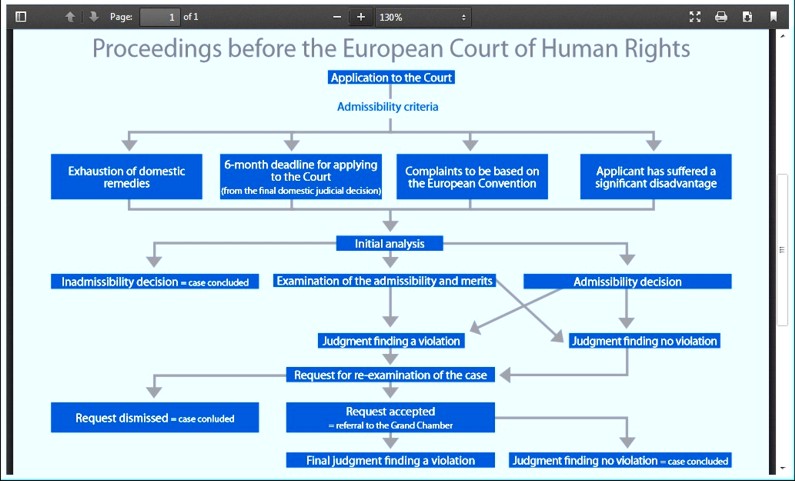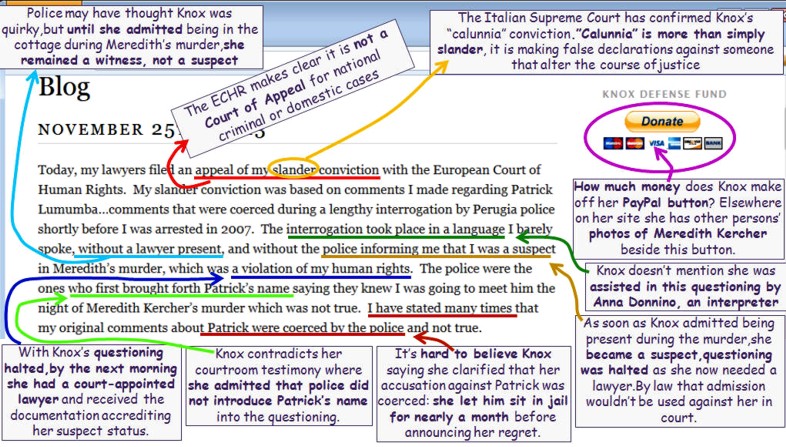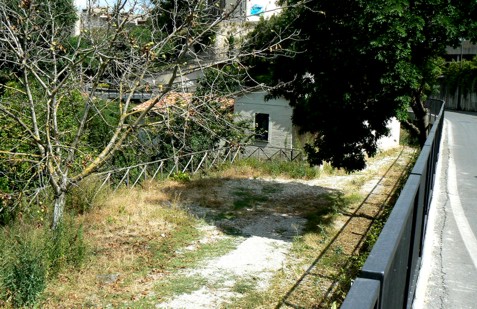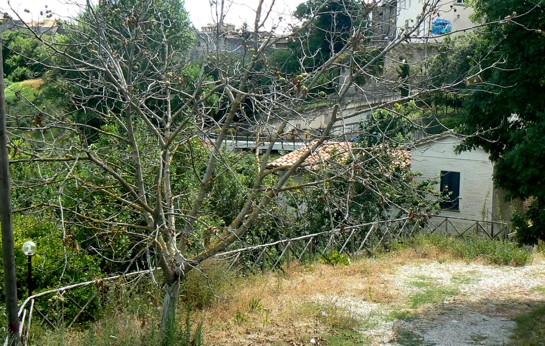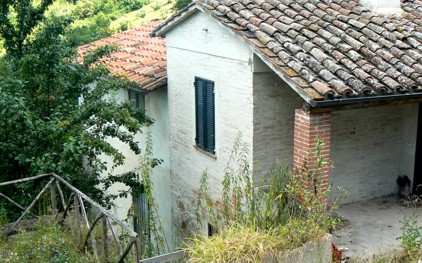
Category: Amanda Knox #2
Wednesday, December 18, 2013
Demonizations By Knox: Multiple Ways In Which Her Email To Judge Nencini Is Misleading
Posted by FinnMacCool
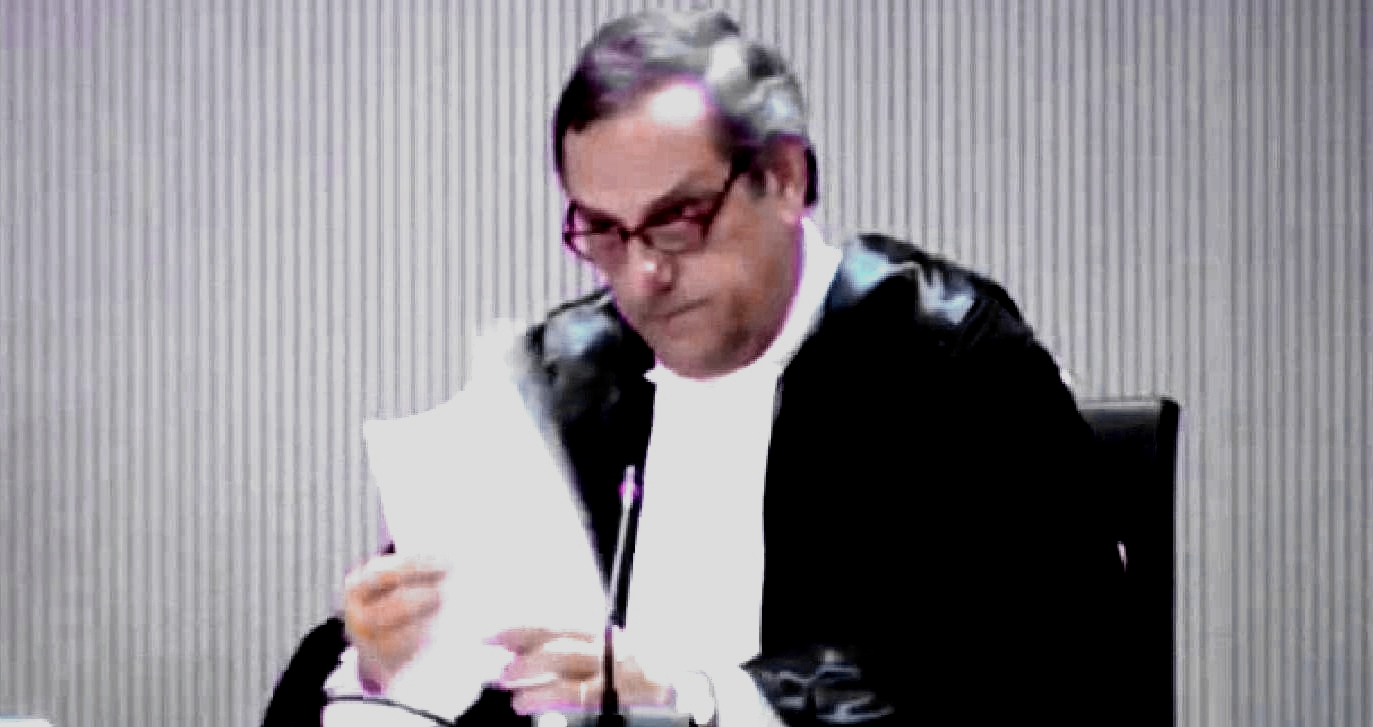
You can read here the email Amanda Knox sent to Judge Nencini.
It is dated 15 December 2013 and was handed to Dr Nencini by Dr Ghirga, apparently to the disdain of both of them. It contains many statements which, if she were under oath, could be considered perjury.
One telling point is that she claims “I am not present in the courtroom because I am afraid.” Her co-defendant, Raffaele Sollecito, was not at all afraid of being at their own appeal, and he did present himself at an earlier stage of the proceedings.
He made a spontaneous statement and the judge assured him that he should feel free to intervene to make further interventions whenever he wished. So far he hasn’t wished to - he preferred to head back to the Caribbean for his holiday.
But that event and that presence by Sollecito completely undermine the credibility of Knox’s claim that she feels afraid of the court proceedings. As it is her own appeal, there would be nothing to stop her coming and going, at any stage, just as Sollecito did.
I have no doubt that my lawyers have explained and demonstrated the important facts of this case that prove my innocence and discredit the unjustified accusations of the prosecution and civil parties.
That’s what her lawyers were about to try to do. But instead they had to hand this email to the judge, showing their client’s complete contempt for the court process.
I seek not to supplant their work
She doesn’t want to supplant the work of her own lawyers? Most defendants don’t, nor do they feel the need to tell the court that using an archaic seventeenth-century grammatical construction (where modern English would have “I do not mean to…” or “I do not wish to”).
Because I am not present to take part in [my own appeal], I feel compelled to share.
As Judge Nencini said, if anyone wants to talk to a court, come to that court. Knox chose not to be present, which means that the word “because” is not a logical connector for why she feels compelled to share what she thinks. “Even though” would make more sense.
The Court has access to my previous declarations and I trust will review them…
The court has access to thousands of pages. Everybody trusts that courts will review the evidence before passing judgment - that’s how the legal process works.
I must repeat: I am innocent.
In fact, she does not have to repeat that, which is simply a reiteration of her not-guilty plea.
I am not present in the courtroom because I am afraid.
The wording is reminiscent of a previous declaration, “I am very afraid of Patrik, the African boy who…” Also the court may remember the presence of her co-defendant, who made a brief presentation to the court (and was invited to intervene again at any time he saw fit) and who afterwards flew back to his extended vacation in the Dominican Republic. It is difficult to see what the defendants have to be afraid of from the court - except perhaps the truth.
I am afraid that the prosecution’s vehemence will leave an impression on you, that their smoke and mirrors will blind you.
The prosecution’s case has already been made; this was the opportunity for the defense to make their case. It is the court’s duty to consider the evidence without being overly swayed by the vehemence of lawyers from either side - they look at the facts, and pass judgment based on that, and this happens in literally millions of cases every year. (Cassazione alone reviews more than 80 thousand cases each year.)
This is not for lack of faith in your powers of discernment, but because the prosecution has succeeded before in convincing a perfectly sound court of concerned and discerning adults to convict innocent people - Raffaele and me.
The second half of the sentence contradicts the first. The writer is explicitly stating that she doubts that the court has sufficient powers of discernment to be able to see through the prosecution’s arguments. Her justification for saying this is simply that it has happened before, with a previous court.
I’ve attentively followed this process and gleaned the following facts…
This is a delusional statement. The writer is the appellant, the initiator of the process, not an external observer to it. We can compare it with her statements following her arrest, in which she claimed still to be helping the police on an equal basis with them, despite being charged with the murder.
No physical evidence places me in Meredith’s bedroom, the scene of the crime…
The bedroom is where the murder took place, but the crime scene is much wider than that, and certainly encompasses the adjoining room where the burglary was faked, the bathroom where the killers cleaned up, and the corridor that connects those rooms. Knox’s blood, DNA, bare footprints are all found in those places. Within Meredith’s room itself, there is also a woman’s shoeprint that does not match the victim, and which Knox’s own lawyer was obliged to claim was caused by an unfortunate fold in the pillowcase.
Meredith’s murderer left ample evidence in the brutal scenario: handprints, footprints, shoe prints in Meredith’s blood, DNA in her purse, on her clothing, in her body.
The term “brutal scenario” makes no sense here, although she repeats it again a couple of lines later. Perhaps she means “crime scene” or “bedroom”. The only footprints found at the crime scene are those of Knox and Sollecito. A woman’s shoeprint in the room where the murder took place cannot be that of either Guede or the victim, and is most likely that of Knox.
The prosecution has failed to explain how I could have… been the one to fatally wound Meredith ““ without leaving any genetic trace of myself. That is because it is impossible.
Actually it is perfectly possible to do this ““ for example, simply by stabbing someone to death while wearing gloves. However, in this case the prosecution has in fact explained how several traces of Knox’s DNA have been found on the handle of the knife which had the victim’s DNA on the blade. That obviously fits a scenario in which Knox stabbed Meredith Kercher with that knife.
Either I was there, or I wasn’t.
The same thing applies to the appeal court. Either the defendants are there, or they are not. In this case, the defendant is not.
The analysis of the crime scene answers this question: I wasn’t there.
Knox’s footprints, blood and DNA, sometimes mixed with that of the victim, all place her at the crime scene, and so does her DNA on the handle of the murder weapon.
My interrogation was illegal and produced a false “confession” that demonstrated my non-knowledge of the crime.
“Non-knowledge” is a curious word. Knox’s witness interview was perfectly legal ““ it was only the unexpected confession from the witness that changed the status of that interview, so that its contents could no longer be used against her. But there is no question over its legality.
The subsequent memoriali, for which I was wrongfully found guilty of slander…
This is an extraordinary aside. The defendant is here rejecting the legitimacy of the Italian Supreme Court, which has definitively found against her, and is also rejecting the findings of the Hellmann court that provisionally freed her, pending appeal. Every single court has found against her on this count.
. ...did not further accuse but rather recanted that false “confession”.
Let us reread some excerpts from this supposed recantation: “After dinner I noticed there was blood on Raffaele’s hand… I stand by my statements that I made last night about events that could have taken place in my home with Patrik… In these flashbacks I’m having, I see Patrik as the murderer…Why did I think of Patrik?... Is there any other evidence condemning Patrik or any other person?” This is not a recantation, and it does in fact contain further accusations of Patrick Lumumba while also seeking to throw suspicion both on Sollecito and an unnamed “other person”.
My behavior after the discovery of the murder indicates my innocence.
As dozens of witnesses have testified in a series of trials and appeals, Knox’s post-murder behavior indicated the exact opposite, which is why suspicion fell on her in the first place.
I did not flee Italy when I had the chance.
On page 71 of her memoir, Knox recounts the following exchange with Officer Ficarra, on the day after the murder was discovered: “My parents want me to go to Germany to stay with relatives for a couple of weeks. Is that okay?” She said, “You can’t leave Perugia. You’re an important part of the investigation.”
I stayed in Perugia and was at the police’s beck and call for over 50 hours in four days.
Chapter Ten of her memoir gives her own account of what she did on Monday, November 5th. She went to a nine o’clock grammar class, at which she refused to discuss the case with her fellow students; she spoke on the phone with her Aunt Dolly, admitting that she had not yet contacted the US embassy; she bumped into Patrick Lumumba where she refused to talk to BBC reporters; she spent the afternoon with Sollecito and then accompanied him to a friend’s house where she played the ukulele. Far from being at the police’s beck and call, she ignored their request that she stay home while they interview Sollecito separately, and turned up to the Questura regardless, although not before they had finished their evening meal.
The police coerced me into signing a false “confession””¦.
Her false accusation of Patrick Lumumba, for which she was convicted and has already served four years in prison, was not a confession and was not coerced.
. “¦one may be coerced into giving a false “confession” because of psychological torture”¦ This is a universal problem.
The US-based Innocence Project reports that there have been 244 exonerations since 2000, which is just over seventeen per year, which in turn means that currently in the USA, roughly 0.1% of cases are eventually overturned. Being wrongfully convicted might be devastating for the person concerned, but it is not a universal problem.
I did not carry around Raffaele’s kitchen knife.
The defendant has not been accused of carrying the knife around, but rather of stabbing Meredith Kercher to death with it. Forensic evidence supports that accusation, too.
I had no contact with Rudy Guede. Like many youth in Perugia, I had once crossed paths with Rudy Guede.
Very typical of Knox’s writing is this kind of self-contradiction, sometimes occurring within the same sentence, or as in this case, in consecutive sentences, seemingly with no self-awareness that any contradiction has even occurred.
If the prosecution truly had a case against me, there would be no need for these theatrics.
The prosecution is present in the court, having made its presentation in the usual way. The defense lawyers are about to do exactly the same thing. The only theatrics happening in the court at that moment is a bizarre email sent by one of the defendants, in lieu of attending her own appeal to her own murder conviction.
But because no evidence exists that proves my guilt, the prosecution would seek to deceive you with these impassioned, but completely inaccurate and unjustified pronouncements.
No further comments.
Monday, December 02, 2013
A Second Analysis Of Amanda Knox’s Email To Family And Friends Of 4 November 2007 DRAFT
Posted by Peter Quennell
I have been trawling through Knox’s infamous email that she wrote to her “friends” in the US shortly after she had cruelly murdered poor Meredith. Here are my thoughts - apologies to all if I am covering old ground.
I have interspersed Knox’s email record, (as she had written it), with my own comments. Hope they are useful to TJMK’s fight for justice for Meredith.
Email by Amanda Knox
This is an email for everyone, because I’d like to get it all out and not have to repeat myself a hundred times like I’ve been having to do at the police station. Some of you already know some things, some of you know nothing.
This reads as if Knox is establishing an alibi and a chronology from the outset. The structure is an odd mix of quasi-formality and off the cuff anecdote.
She does not feel the need to explain why she has had to repeat herself a hundred times at the police station. After all, an innocent person would tell the truth once, with perhaps minor corrections. Only a person, like Knox, who was changing her story to the police so often, would need to repeat herself endlessly. By default, therefore, she is admitting that her story is proving unbelievable, so this email is her attempt to garner psychological support and credence from her family and friends in the US.
What I’m about to say, I can’t say to journalists or newspapers and I require that of anyone receiving this information as well.
Here and repeated further on in this email, Knox is blatantly breaching the strict advice that she remains publicly silent, particularly in relation to the media. She has no control over this email “information”, once she has sent it to her multiple recipients, because she cannot be sure that it will not leak to third parties.
This is my account of how I found my roommate, murdered, the morning of Friday, November 2nd.
Strictly formal in style, much as one would expect of a written statement to the police. Knox seeks to assuage her psychological turmoil and gain mental control because she knows she has repeatedly lied to the police and none has yet, (understandably), believed her.
The last time I saw Meredith, 22, English, beautiful, funny, was when I came home from spending the night at a friend’s house.
The insertion of “22, English, beautiful, funny” seems completely inappropriate in relation to a recently, brutally murdered Meredith. It reads as if a third-rate novelist is introducing a key character. Thus Knox reveals her email to be a self-serving, imaginary construct ““ not factual and honest, as an innocent person would write.
It was the day after Halloween, Thursday. I got home and she was still asleep, but after I had taken a shower and was fumbling around the kitchen, she emerged from her room with the blood of her costume (vampire) still dripping down her chin.
Showers, in this email, seem to be a major obsession for Knox. Could she be trying to wash away her oppressive psychological feelings of guilt?
We talked for a while in the kitchen, how the night went, what our plans were for the day, nothing out of the ordinary”¦..,
Why should Knox note, “Nothing out of the ordinary” in this routine conversation, other than she is trying to paint a benign landscape of her relationship with Meredith? (In fact, we know from independent witnesses that Meredith had become increasingly annoyed by Knox’s anti-social behaviour around the house)
“¦and I began to start eating a little, while i waited for my friend (Raffaele-at whose house i stayed over) to arrive at my house. He came right after I started eating and he made himself some pasta.
Note Knox’s truly strange attention to detail, “I began to start eating a little” and “He came right after I started eating”. Why the almost millisecond importance of eating? I believe that Knox is highlighting the timing of Sollecito’s arrival to establish that they were therefore together when Meredith was alive and that they remained so until her body would be discovered. This seeks to build an apparently highly accurate and continuous chronology for their alibi.
As we were eating together, Meredith came out of the shower and grabbed some laundry or put some laundry in, one or the other, and returned into her room after saying hi to Raffael
Knox mentions the word “grab” repeatedly throughout this email. It does not signify a factual rush to do something, but her psychological need to create a fleeting impression about recollections that she knows to be untrue.
It is also odd that Knox feels the need to highlight the “laundry”, but is immediately vague on whether or not it was before or after the wash. This is the sort of detail that adds nothing of factual relevance, but tends to create the impression that Knox is making it up as she goes along. Repeatedly, throughout all her statements, she fluctuates between sudden accuracy about certain unimportant facts or those that support her claimed innocence, but becomes, equally suddenly, very “confused” when it relates to important facts that might establish her guilt.
After lunch, I began to play guitar with Raffael and Meredith came out of her room and went to the door. She said bye and left for the day. It was the last time I saw her alive.
This is a very laborious and therefore insincere recall. Most innocent people would simply recall that, “After lunch, Meredith said goodbye and left for the day”. Knox’s attention to detail appears necessary only because she is carefully constructing a knowingly dishonest version of events and placing herself in it, as if she were an innocent spectator.
After a little while of playing guitar, I and Raffael went to his house to watch movies and after, to eat dinner and generally spend the evening and night indoors. We didnt go out.
Once again, Knox takes great care to build a continuous, but dishonest, alibi. She seeks to reassure herself by creating a fantasy narrative, with Sollecito and her as the key actors.
How can one “generally spend the evening and night indoors”? Either they did or they didn’t do so. Period.
Why, if they did stay in, does Knox feel the need to expressly state, “We didn’t go out”?
It would appear that Knox is grappling with her inner knowledge that she is telling whopping great lies, but by repeating them, she can establish the alibi in her mind and also reassure herself, (and the FOA), that she is telling the truth.
The next morning, I woke up around 1030 and after grabbing my few things, I left Raffael’s apartment and walked the five-minute walk back to my house to, once again, take a shower and grab a change of clothes.
As above, we have two instances of “grabbing”, indicating a specific desire to skip quickly across her conscious lies. Knox again stresses a shower, a subconscious effort to cleanse her burdensome knowledge of guilt.
I also needed to grab a mop because, after dinner, Raffael had spilled a lot of water on the floor of his kitchen by accident and didnt have a mop to clean it up.
This is not the first time that Knox alludes to this water issue and therefore, the need to collect the mop from her house. Unfortunately, Sollecito’s and her versions vary between a “spillage” and a “leak” from the sink.
These descriptions mean two different things. A “spillage” indicates a human cause, whereas a leak indicates a failure in the pipes.
Judge Massei has rightly questioned the need to collect a mop from Knox’s house, when Sollecito had a janitor service at his house.
I don’t think anyone on TJFM has suggested a perhaps more likely reason for Knox “grabbing” her mop and taking it to Sollecito’s house, one that has nothing to do with leaks or spillages at the latter house.
We know that there was a concerted clean-up of the murder scene, most likely after Knox had purchased cleaning agents/bleach from the shop, early on the morning of November 2nd 2007. It would make sense that Knox and Sollecito, bare foot, used Knox’s house mop to wash down the floors. It would be potentially very risky to leave that mop at the murder scene thereafter, (no matter how well it was rinsed), for fear that traces of Knox’s and/or Solliceto’s incriminating DNA remained for detection by forensics, mixed with Meredith’s DNA.
It was simply much safer to take the mop away, as they left the house.
It would be interesting to know if the police ever found Knox’s original mop and whether it would have yielded any incriminating DNA evidence.
So, I arrived home and the first abnormal thing I noticed was the door was wide open.
Note: Knox immediately notes that the “wide open” door was “abnormal”.
Here’s the thing about the door to our house:
It’s broken, in such a way that you have to use the keys to keep it closed.
if we dont have the door locked, it is really easy for the wind to
blow the door open and so my roommates and I always have the door
locked unless we are running really quickly to bring the garbage out
or to get something from the neighbors, who live below us.
Who “runs really quickly” to bring garbage out? Only someone like Knox, who is trying to persuade herself and the FOA that it would justify leaving an entrance door “wide open”. Most sensible tenants would have demanded that the landlord repair the door and secure the property, particularly as it housed four young women.
(Another important piece of information: for those who dont know, I inhabit a
house of two stories, of which my three roommates and I share the
second story appartment. there are four Italian guys of our age
between 22 and 26 who live below us. We are all quite good friends and we talk often. Giacomo is especially welcome because he plays guitar with me and Laura, one of my roommates and is, or was, dating Meredith. The other three are Marco, Stefano, and Ricardo.)
Why is this information so “important”, particularly for “those who don’t know”? The only reason seems to be an opportunity for Knox to create the illusion that she was very sociable. We know, according to independent witnesses, that Knox had distinct character quirks that made social contact uncomfortable for all who met her, (bar Solliceto).
Anyway, so the door was wide open. Strange, yes, but not so strange that I really
thought anything about it.
Note: now Knox cannot make up her mind whether the “wide-open” door is “odd/strange” or “not so strange that I really thought anything about it”. The truth is that these expressed reactions are mutually exclusive. Indeed, she goes on immediately to show that she DID think something about it”¦.
I assumed someone in the house was doing exactly what I just said, taking out the trash or talking really quickly to the neighbors downstairs. So I closed the door behind me
but I didnt lock it, assuming that the person who left the door open would like to come back in.
A lot of “thinking” here, all of it a self-serving excuse as to why Knox didn’t call the police straight away.
When I entered, I called out if anyone was there, but no one responded and I assumed that if anyone was there, they were still asleep.
This was another of Knox’s BIG assumptions, taking no care to even consider that there might have been a genuine break-in or that the culprit might be still lurking in the house.
Laura’s door was open which meant she wasn’t home, and Filomena’s door was also closed. My door was open like always and Meredith door was closed, which to me meant she was sleeping.
Knox seems to be so knowledgeable about her housemates’ whereabouts, simply by the status of their respective bedroom doors!
In fact, Knox knew that both Filomena and Laura would be away for the long weekend and that only Meredith would be in the house on 01/11/2007.
I undressed in my room and took a quick shower in one of the two
bathrooms in my house, the one that is right next to Meredith and my
bedrooms, (situated right next to one another).
It was after I stepped out of the shower and onto the mat that I noticed the blood in the
bathroom. It was on the mat I was using to dry my feet and there were
drops of blood in the sink.
At first, I thought the blood might have come from my ears, which I had pierced extensively not too long ago, but then, immediately, I know it wasn’t mine because the stains on the mat
were too big for just droplets from my ear, and when I touched the
blood in the sink it was caked on already.
Who pierces their ears “extensively”? Knox, here, is desperate to try to link bleeding from alleged tiny earlobe punctures with the volume of blood visible in the sink and on the mat.
There was also blood smeared on the faucet. Again, however, I thought it was strange
because my roommates and I are very clean and we wouldn’t leave blood
in the bathroom, but I assumed that perhaps Meredith was having
menstral issues and hadn’t cleaned up yet. Ew, but nothing to worry
about.
Again, lots of “strange” blood that Knox immediately seeks to explain away by careless and indeed ridiculous “menstral” bleeding.
More importantly, note here that Knox only considers that she and/or Meredith could be the only source of the blood. She had arrived back to a “wide-open” door, which could have allowed any bleeding person to enter the bathroom unimpeded.
In fact, Knox is grappling again with her knowledge that the blood is a mixture of Meredith’s and her own DNA. By suggesting her bleeding ear piercings and Meredith’s “menstral issues”, Knox is making a feeble attempt to put together an innocent, advance explanation for any mixture of Meredith’s and her blood that subsequent forensic examination might identify.
Still, Knox shows not the slightest concern that her house is “wide-open” and there is blood in the bathroom. An innocent person would have immediately contacted her housemates, accounted for their safety and then called the police.
I left the bathroom and got dressed in my room. After I got
dressed, I went to the other bathroom in my house, the one that
Filomena and Laura use, and used their hairdryer to obviously dry my
hair”¦
Why does Knox state “”¦.obviously to dry my hair”? Why otherwise would anyone normally use a hair dryer?
“¦ and it was after I was putting back the dryer that I noticed the
shit that was left in the toilet, something that definitely no one in
our house would do.
NOTE: Knox confirms here that she first noticed the “shit” in Filomena and Laura’s toilet and that it could not be that of any of the housemates.
I started feeling a little uncomfortable.
Only a “little”? How many indications did Knox need to conclude that something was seriously amiss? Still, she made no call to the police or her housemates.
Note again that she only “started” to feel uncomfortable ““ no more than that. She constantly seeks to express her alleged concern on one hand and simultaneously write it off on the other.
and so I grabbed the mop from out closet and left the house, closing and locking the door that no one had come back through while I was in the shower, and I returned to Raffael’s place.
This is another “grabbing” remark to skip over another deliberate untruth. It also seems to imply that her discomfort made her leave the house in a hurry, (see below).
How does Knox know whether or not anyone had come in through the open door, while she was in the shower?
After we had used the mop to clean up the kitchen, I told Raffael about what I had seen in the house over breakfast. The strange blood in the bathroom, the door wide open, the
shit left in the toilet. He suggested I call one of my roommates, so I
called Filomena.
So here we have Knox, having left her house feeling “uncomfortable” for all the reasons that she stated in this paragraph, but then goes to Sollecito’s house where she and Sollecito allegedly “cleaned up the kitchen”, (note: not “”¦.mopped up the water spillage/leak”).
They then make breakfast and it is only “over breakfast” that Knox gets round to sharing this troubling and uncomfortable information with Sollecito.
An honest person would have told Sollecito straight away, upon her return. Why was Knox so nonchalant about the “strange” things at her house? Perhaps because she and Sollecito, (as the murderers), already knew all about them and that she is now constructing this fantasy alibi to cover their guilty asses.
Filomena had been at a party the night before with her boyfriend, Marco, (not the same Marco who lives downstairs but we’ll call him Marco-f as in Filomena and the other can be Marco-n as in neighbor).
She also told me that Laura wasn’t at home and hadn’t been
because she was on business in Rome. which meant the only one who had
spent the night at our house last night was Meredith, and she was as
of yet unaccounted for.
Knox therefore confirms that she already knew that both Filomena and Laura were out of town for the long weekend. Filomena testified that she had asked Amanda, on the afternoon of 01/11/2007, to help her wrap a birthday present for the party.
Filomena seemed really worried, so I told her I’d call Meredith and then call her back.
Knox seems quite surprised at the extent of Filomena’s worried response. The real surprise is that Knox is the only one, of all the housemates and Meredith’s friends, who behaved in a totally inappropriate and cold manner, both leading up to the discovery of Meredith’s body and particularly afterwards at the police station.
The phone record shows that Knox is telling more lies here ““ she had already rung Meredith’s phones before ringing Filomena.
Judge Massei found that Knox had done so, not out of any concern about Meredith, (the calls only lasted 3 or 4 seconds), but to establish that the discarded phones had not yet been found. Having satisfied herself that the phones remained undiscovered and that no investigation could yet be underway, the coast was clear for Knox to ring Filomena and thereby set the wheels in motion of the inevitable discovery of Meredith’s body.
I called both of Meredith’s phones, the English one first and last and the Italian one between.
No, this was BEFORE Knox first called Filomena, (see above). The phone record completely destroys Knox’s alleged call chronology and proves her, without doubt, to be a liar.
The first time i called the English phone, it rang and then sounded as if
there was disturbance, but no one answered.
What kind of “disturbance”? Was Knox trying to imply that someone else had the phone at that stage?
I then called the Italian phone and it just kept ringing, no answer.
I called her English phone again and this time an English voice told me her phone was out of
service.
Oh well, Knox, never mind”¦.
Raffael and I gathered our things and went back to my house.
I unlocked the door and I’m going to tell this really slowly to get
everything right, so just have patience with me.
Revealingly, Knox had to warn herself to be careful here ““ she wouldn’t want a slip up in her alibi, would she? No innocent person would ever have the need to write such a phrase.
The living room/kitchen was fine. Looked perfectly normal. I was checking for
signs of our things missing, should there have been a burglar in our
house the night before.
Why did she not do this when she had first gone to her house earlier that morning?
Filomena’s room was closed, but when I opened the door, her room was a mess and her window was open and completely broken, but her computer was still sitting on her desk like, it always was and this confused me.
Yes, Knox, of course it did, but you bravely persevered with your search”¦
Convinced that we had been robbed, I went to Laura’s room and looked quickly in, but it was spotless, like it hadn’t even been touched. This, too, I thought was odd.
This alleged robbery becomes even more strange for Knox ““ “convincing” but at the same time, “odd”. The only explanation, (which she knew and was discovering more and more flaws in it), was that it was a “staged” break-in of Sollecito’s and her own making.
I then went into the part of the house that Meredith and I share and checked my room
for things missing, which there weren’t.
Phew, that must have been a relief! Most (innocent) people would have checked their own room first.
Then I knocked on Meredith’s room, but when she didnt respond. I knocked louder and louder until I was really banging on her door and shouting her name. No response.
Either Meredith wasn’t in, (the most likely reason) but she had not answered her phones.
Why did Knox not call the police immediately?
Panicking, I ran out onto our terrace to see if maybe I could see over the ledge into her
room from the window, but I couldn’t see in. Bad angle.
The “angle” was the same as it had always been. It was only a small house. Why did Knox allegedly try to see through Meredith’s window when it was out of the line of sight from the terrace?
I then went into the bathroom where I had dried my hair and looked really quickly
into the toilet. In my panic, I thought I hadn’t seen anything there,
which to me meant whoever was in my house had been there when I had
been there.
As it turns out, the police told me later that the toilet was full and that the shit had just fallen to the bottom of the toilet, so I didnt see it.
Why, in a state of panic, did Knox suddenly decide to inspect the toilet bowl in Filomena’s bathroom? Knox has already written, (see above, in this discussion), that she had noticed the unusual “shit” in the toilet during her first visit to the house earlier that morning.
Why would the police discuss with Knox the position of the “shit” as a means of helping her to understand why she had completely failed to notice it in her “panic”?
Knox deduces that whoever had left the shit in the bowl had been there when she was there. It turned out to be Guede’s shit, therefore Knox is admitting that she was with Guede on the night of Meredith’s murder and Guede has been convicted of the crime - one for which he is co-responsible with Knox and Sollecito.
I ran outside and down to our neighbors’ door. The lights were out, but I banged on the door anyway. I wanted to ask them if they had heard anything the night before, but no one was
home. I ran back into the house.
Knox knew that the boys downstairs were going away for the long weekend before she murdered Meredith. Why would Knox have pounded of the door of a house that she had known was empty?
In the living room, Raffael told me he wanted to see if he could break down Meredith’s door. He tried, and cracked the door, but we couldn’t open it. It was then that we decided
to call the cops.
What a wimp! The housemates’ boyfriends, when they discovered that Meredith was missing and that her door (unusually) locked, had no trouble breaking down the door and unlike Sollecito, they were not trained in kick-boxing.
Finally, they called the cops!! Knox did so with no urgency whatsoever. She and Sollecito delayed calling the police for as long as possible, to give themselves time to construct an agreed alibi and to check that everything was in place, at the murder scene, to indicate a “lone wolf” break in and attack on Meredith.
There are two types of cops in Italy, Carabinieri, (local, dealing with traffic and domestic calls) and the police investigators.
He first called his sister for advice and then called the Carbanieri.
I then called Filomena, who said she would be on her way home immediately.
Knox is a liar here again. These remarks are unsupported by the phone record.
While we were waiting, two ununiformed police investigators came to our house. I showed them what I could and told them what I knew. Gave them phone numbers and explained a bit in broken Italian, and then Filomena arrived with her boyfriend, Marco-f
and two other friends of hers.
These uniformed police confirmed that both Knox and Sollecito looked very surprised to see them. Neither of them knew that the phones had been discovered, (ironically one had been discovered when Knox had rung it a little earlier), and that these police had arrived to investigate their loss and return them to Filomena and Meredith.
No word from Knox as to why she and Sollecito were surprised to see these police.
All together, we checked the house out, talked to the police and in a bit, they all opened Meredith’s door.
I was in the kitchen, standing aside, having really done my part for
the situation. But when they opened Meredith’s’ door and I heard
Filomena scream, “a foot! a foot!”, in Italian, I immediately tried to
get to Meredith’s room, but Raffael grabbed me and took me out of the
house.
This is a complete fabrication. Knox speaks as someone who knew that the opened bedroom door would reveal Meredith’s body. No innocent person would stand back, aloof and disinterested, when all the others were anxious to break down the door.
Which innocent person would lapse into complete disinterest because “I had already done my part for the situation”. Sounds as if Knox felt she had acted that part of the planned alibi script and was waiting to resume the act at a later stage.
Knox then tries to establish that she tried to get to Meredith’s room because Filomena had screamed “a foot”. Again, Sollecito saved the day by “grabbing”, (that word again!), her and taking her outside because Filomena had screamed out “a foot”.
It is a fact that both Knox and Sollecito obviously knew details of the murder scene, but had not been present to see into the bedroom when the door had been broken down.
Thus, Knox is trying here to establish how she knew about the disposition of Meredith’s body, without needing a line of sight on the murder scene.
The police told everyone to get out and not long afterward the
Carabinieri arrived and then soon afterward, more police
investigators. They took all of our information and asked us the same
questions over and over.
The police had not asked the same questions “over and over” of any other, (innocent), witnesses, just of Knox and Solliceto. Why? I suspect that only Knox and Sollecito needed repeated questions because only they were telling inconsistent and changing stories.
Knox simply does not understand that the police only tend to ask the same questions “over and over” if the witness is being dishonest and evasive by giving inconsistent and contradictory answers. She may as well admit that her answers were and are just that.
At the time, I had only what I was wearing and my bag, which thankfully had my passport in it and my wallet. No jacket though, and I was freezing.
Was Knox trying to cover up her nervous trembles, during her answers to difficult questions, by trying to claim here that she was “freezing”?
After sticking around at the house for a bit, the police told us to go to the station to give testimony, which I did.
I was in a room for six hours straight after that, without
seeing anyone else, answering questions in Italian for the first hour
and then they brought in an interpreter and he helped me out with the
details that I didnt know the words for..
An innocent person would never submit to an interview in a murder case, without fluency in the local language
Knox repeats here the allegations of extended questioning and sleep/food/water deprivation to try to excuse her admissions in her signed, written statements. The facts show that she had only about three hours of questioning, the remainder of the time at the police station being spent on giving long, voluntary accounts of her part in the events, at her request.
No person EVER admits to a callous murder, except perhaps under overt torture. Knox has never claimed torture during questioning.
They asked me, of course, about the morning, the last time I saw her, and because I was the closest to her, questions about her habits and her relationships.
Here, Knox is attempting to create an untruthful impression of a close and warm relationship with Meredith. Meredith’s friends consistently claim to the contrary.
Afterwards, when they were taking my fingerprints, I met two of
Meredith’s English friends, two girls she goes out with, including the
last one who saw her alive that night she was murdered. They also had
their prints taken.
After that, (this was around 9 at night by this time), I was taken into the waiting room where there was various other people who I all knew from various places, who all knew Meredith. Her friends from England, my roommates, even the owner of the pub she most
frequented.
After a while, my neighbors were taken in too, having just arrived home from a weeklong vacation in their home town, which explained why they weren’t home when I banged on their door.
Of course it did, Knox. You knew that the neighbours had gone away for the weekend. In fact, as you knew that only Meredith would be in the house, it was a perfect opportunity to assault and murder her.
Later than that, another guy showed up and was taken in for questioning, a guy I
dont like, but whom both Meredith and I knew from different occasions, a
Moroccan guy that I only know by his nickname amongst the girls,
“shaky”.
Big, bad BLACK guy, that is, not an all-American, sweet, apple pie gal like good ole Amanda…
Then I sat around in this waiting room, without having the
chance to leave or eat anything besides vending machine food, (which
gave me a hell of a stomach ache) until 5:30 in the morning.
Knox made no official complaint about this alleged mistreatment by the police. On the contrary, she confirmed, in court, that the police had treated her well, including supplying food and drinks to her. More lies.
During this time, I received calls from a lot of different people, family
mostly of course, and I also talked with the rest, especially to find
out what exactly was in Meredith’s room when they opened it. Apparently
her body was lying under a sheet, and with her foot sticking out and
there was a lot of blood. Whoever had done this had slit her throat.
Here, Knox records another explanation of how she knew about the crime scene details, while never having been in the position to see them. These are lies, again, of course.
They told me to be back in at 11am. I went home to Raffael’s place,
ate something substantial and passed out.
Altogether, what with the murder, staged break in, intensive overnight cleanup of the murder scene, giving consistently contradictory evidence to the police and maintaining an aura of sweet innocence, I am not surprised that Know alleges that she “passed out”. She must have been knackered. Photos of the pair on the morning after the murder show both to be drawn and unkempt.
In the morning, Raffael drove me back to the police station, but had to
leave me when they said they wanted to take me back to the house for
questioning.
Before I go on, I’d like to say that I was strictly told not to speak about this, but I’m speaking with you people who are not involved and who can’t do anything bad except talk to journalists, which I hope you won’t do. I have to get this off my chest because it’s
pressing down on me and it helps to know that someone besides me knows
something and that I’m not the one who knows the most out of everyone.
Why does Knox reveal information here, about which she had been “strictly told” not to speak? This shows her unwillingness to accept any boundaries in her behaviour.
What is pressing on Knox’s chest? The guilt of having murdered Meredith or more likely, that she cannot persuade anyone, (outside the FOA), to believe her changing stories and denials of fact.
Knox inadvertently concedes here that she “”¦ knows the most out of everyone”. I would suggest that the only way to know that much is to be the murderess.
Pathetically, she is seeking to share her guilt by passing the buck of responsibility onto others, who by swallowing her stories, hook, line and sinker, can become witting or unwitting co-conspirators in her deception.
At the house, they asked me very personal questions about Meredith’s
life and also about the personalities of our neighbors. How well did I
know them? Pretty well, we are friends. Was Meredith sexually active?
Yeah, she borrowed a few of my condoms. Does she like anal? WTF? I
dont know. Does she use Vaseline for her lips? What kind of person is
Stefano? Nice guy, has a really pretty girlfriend.
I have no doubt that Knox could fill in any gaps in her knowledge here by telling her usual lies, as she always has done and continues to do.
Hmmm”¦very interesting. We’d like to show you something, and tell us if this is
out of normal.
Why would the police rely on Knox for an honest answer to ANY question?
They took me into the neighbors’ house. They had broken the door open
to get in, but they told me to ignore that.
Why would the police have broken the door down, rather than simply call the young men home and keep their part of the house sealed off until they had arrived?
The rooms were all open. Giacomo’s and Marco-n’s rooms were spotless, which made sense because the guys had thoroughly cleaned the whole house before they left on
vacation.
This is Knox reaching quick conclusions on matters about which she has no knowledge. How ironic that she cannot reach any consistent and revealing conclusion about Meredith’s murder, about which she knows so much
!
Stefano’s room however, well, his bed was stripped of linens,
which was odd, and the comforter he used was shoved up at the top of
his bed, with blood on it. I obviously told then that the blood was
definitely out of normal and also that he usually has his bed made.
They took note of it and ushered me out.
How can Knox be such an expert about Stephano’s room, his blood and his personal habits? More lies and fantasy.
When I left the house to go back to the police station, they told me to put my jacket over my head and duck down below the window, so the reporters wouldn’t try to talk to
me.
At the station, I just had to repeat the answers that I had given
at the house, so they could type them up and after a good 5 and a half
hour day with the police again, Raffael picked me up and took me out
for some well-deserved pizza. I was starving.
Again, Knox admits that she has to answer the same, repeated questions, oblivious to the fact that this must imply that her answers are inconsistent and God Forbid, dishonest.
I then bought some underwear because, as it turns out, I won’t be able to leave Italy for a
while, as well as enter my house. I only had the clothes I was wearing the day it began, so i bought some underwear and borrowed a pair of pants from Raffael.
So Knox only buys underwear because she cannot leave Italy or enter the house? Does she not need any other clothes?
Spoke with my remaining roommates that night (last night) and it was a hurricane of emotions and stress, but we needed it anyway.
I would suspect Knox, more than anybody, to be at the centre of the “hurricane”. Innocent people would be upset for Meredith’s loss, but would not experience anything like Knox’s stress, as a murderess trying to concoct a consistent alibi, without success.
What we have been discussing is basically what to do next. We are trying to keep
our heads on straight.
Knox, here, is admitting that she was exercised in keeping her concentration on the next phase of maintaining her concoction of lies.
First things first though, my roommates both work for lawyers, and they are going to try to send a request through on Monday to retrieve important documents of ours that are still in
the house.
These “documents” were obviously much more important than Meredith’s murder. Knox is such a narcissist ““ everything is all about her.
Secondly, we are going to talk to the agency that we used to find our house and obviously request to move out. It kind of sucks that we have to pay the next month’s rent, but the owner has protection within the contract.
Such a shame! Obviously Knox did not foresee that murdering Meredith might cost her a month’s extra rent.
After that, I guess I’ll go back to class on Monday, although I’m not sure what I’m going to do about people asking me questions, because I really dont want to talk again about what
happened. I’ve been talking an awful lot lately and I’m pretty tired of
it. After that, it’s like I’m trying to remember what I was doing before
all this happened. I still need to figure out who I need to talk to and what I need to do to continue studying in Perugia, because it’s what I want to do.
Yes, Knox, don’t let your murder of Meredith interrupt your study and future plans.
Anyway, that’s the update, feeling okay,
Better now for off-loading all this rubbish? Here’s a bit of advice, Knox, if you truly wish to offload your burden, tell the truth of your involvement in Meredith’s cruel murder.
Hope you all are well,
Amanda.
Yeah - right!
Saturday, November 30, 2013
Note For Strasbourg Court & State Department: Knox Herself Proves She Lies About Her Interrogation
Posted by James Raper

In our previous post Kermit nicely shows how, under the European Court of Human Rights’ own guidelines, Amanda Knox’s “appeal” won’t put her out of reach of the fair and painstaking Italians.
If any of the busy, hard-pressed ECHR investigators do choose to press beyond the ECHR guidelines, they will almost instantly establish that in her voluntary interview on 5 November 2007 Knox was treated with complete fairness.
Also that her false accusation of Patrick (which she never retracted) was entirely of her own doing.
And also that she is not only trying to throw sand into the wheels of Italian justice during an ongoing judicial process (a felony in Italy) but she is trying to welsh out of paying Patrick his damages award of $100,000 (a contempt of the Supreme Court) thus foolishly risking two more charges of aggravated calunnia.
This post derives from a post of mine last May. In another post, we showed that Dr Mignini was not present for the interrogation that night, and Knox maliciously invented an illegal interrogation at risk of a third aggravated calunnia charge.
In fact Dr Mignini met with Amanda Knox only briefly, later, to charge her and to warn she should say no more without a lawyer. He asked her no questions.
I will compare the various accounts of the interrogation to demonstrate that Amanda Knox is indeed lying to the ECHR, just as she did repeatedly in her book this year and also on US and European television.
- There are two main bodies of truth about the interrogation: (1) all of those present at various times on that night and (2) Knox’s own testimony on the witness stand in mid 2009.
- There are two main bodies of lies about the interrogation (1) The Sollecito book and (2) the Knox book, which by the way not only contradict one another but also contradict such other accounts as those of Saul Kassin and John Douglas.
The police had called her boyfriend Raffaele Sollecito in to the station for questioning and Knox had accompanied him because she did not want to be alone. They had already eaten at the house of a friend of Sollecito’s.
Knox’s interrogation was not tape recorded and in that sense we have no truly independent account of what transpired. The police, including the interpreter, gave evidence at her trial, but we do not yet have transcripts for that evidence other than that of the interpreter. There are accounts in books that have been written about the case but these tend to differ in the detail. The police and the interpreter maintain that she was treated well. Apart from the evidence of the interpreter all we have is what Knox says happened, and our sources for this are transcripts of her trial evidence and what she wrote in her book. I shall deal with the evidence of the interpreter towards the end of this article.
I am going to compare what she said at trial with what she wrote in her book but also there was a letter she wrote on the 9th and a recording of a meeting with her mother on the 10th November which are relevant.. What she wrote in her book is fairly extensive and contains much dialogue. She has a prodigious memory for detail now which was almost entirely lacking before. I am going to tell you to treat what she says in her book with extreme caution because she has already been found out for, well let us say, her creative writing if not outright distortion of facts. I shall paraphrase rather than quote most of it but a few direct quotes are necessary.
Knox arrived with Sollecito at the police station at about 10.30 pm (according to John Follain). The police started to question Sollecito at 10.40 pm (Follain).
In her book Knox describes being taken from the waiting area to a formal interview room in which she had already spent some time earlier. It is unclear when that formal questioning began. Probably getting on for about 11.30pm because she also refers to some questions being asked of her in the waiting room following which she did some stretches and splits. She then describes how she was questioned about the events over a period from about the time she and Sollecito left the cottage to about 9 pm on the 1st November.
Possibly there was a short break. She describes being exhausted and confused. The interpreter, Knox says, arrived at about 12.30 am. Until then she had been conversing with the police in Italian.
Almost immediately on the questioning resuming -
“Monica Napoleoni, who had been so abrupt with me about the poop and the mop at the villa, opened the door. “Raffaele says you left his apartment on Thursday night,” she said almost gleefully. “He says that you asked him to lie for you. He’s taken away your alibi.””
Knox describes how she was dumfounded and devastated by this news. She cannot believe that he would say that when they had been together all night. She feels all her reserves of energy draining away. Then -
“Where did you go? Who did you text?” Ficarra asked, sneering at me.
“I don’t remember texting anyone.”
They grabbed my cell phone up off the desk and scrolled quickly through its history.
“You need to stop lying. You texted Patrick. Who’s Patrick?”
“My boss at Le Chic.”
Stop right there.
How were the police able to name the recipient of the text? The text Patrick had sent her had already been deleted from Knox’s mobile phone by Knox herself and Knox hasn’t yet named Patrick. In fact she couldn’t remember texting anyone.
It is of course probable that the police already had a log of her calls and possibly had already traced and identified the owner of the receiving number for her text, though the last step would have been fast work.
In her trial testimony Knox did a lot of “the police suggested this and suggestd that” though it is never crystal clear whether she is accusing the police of having suggested his name. But she is doing it here in her book and of course the Knox groupies have always maintained that it was the police who suggested his name to her.
The following extract from her trial testimony should clear things up. GCM is Judge Giancarlo Massei.
GCM: In this message, was there the name of the person it was meant for?
AK: No, it was the message I wrote to my boss. The one that said “Va bene. Ci vediamo piu tardi. Buona serata.”
GCM: But it could have been a message to anyone. Could you see from the message to whom it was written?
AK: Actually, I don’t know if that information is in the telephone”¦”¦”¦”¦”¦”¦”¦..
GCM : But they didn’t literally say it was him!
AK : No. They didn’t say it was him, but they said “We know who it is, we know who it is. You were with him, you met him.”
GCM : Now what happened next? You, confronted with the message, gave the name of Patrick. What did you say?”
AK : Well, first I started to cry…....
And having implied that it was the police who suggested Patrick’s name to her, she adds”¦.. that quote again -
“You need to stop lying. You texted Patrick. Who’s Patrick?”
“My boss at Le Chic.”
Here she is telling the Perugian cops straight out exactly to whom the text was sent. “My boss at Le Chic”.
But that does not quite gel with her trial testimony -
And they told me that I knew, and that I didn’t want to tell. And that I didn’t want to tell because I didn’t remember or because I was a stupid liar. Then they kept on about this message, that they were literally shoving in my face saying “Look what a stupid liar you are, you don’t even remember this!”
At first, I didn’t even remember writing that message. But there was this interpreter next to me who kept saying “Maybe you don’t remember, maybe you don’t remember, but try,” and other people were saying “Try, try, try to remember that you met someone, and I was there hearing “Remember, remember, remember…..
Doesn’t the above quote make it clear that the police were having considerable trouble getting Knox to tell them to whom her text message was sent? It would also explain their growing frustration with her.
But perhaps the above quote relates not to whom the text was sent but, that having been ascertained, whether Knox met up with that person later? Knox has a habit of conflating the two issues. However there is also the following quote from her trial testimony -
Well there were lots of people who were asking me questions, but the person who had started talking with me was a policewoman with long hair, chestnut brown hair, but I don’t know her. Then in the circle of people who were around me, certain people asked me questions, for example there was a man holding my telephone, and who was literally shoving the telephone into my face, shouting “Look at this telephone! Who is this? Who did you want to meet?”
Then there were others, for instance this woman who was leading, was the same person who at one point was standing behind me, because they kept moving, they were really surrounding me and on top of me. I was on a chair, then the interpreter was also sitting on a chair, and everyone else was standing around me, so I didn’t see who gave me the first blow because it was someone behind me, but then I turned around and saw that woman and she gave me another blow to the head.
The woman with the long hair, chestnut brown hair, Knox identifies in her book as Ficarra. Ficarra is the policewoman who started the questioning particularly, as Knox has confirmed, about the texted message. “Look at this telephone! Who is this? Who did you want to meet?” Again, surely this is to get Knox to identify the recipient of the text, not about whether she met up with him?
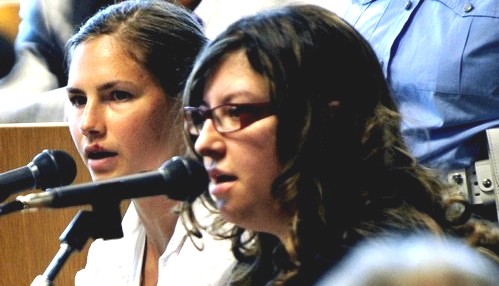
In the book though, it is all different.
In the book, the police having told her that the text is to someone called Patrick, Knox is a model of co-operation as, having already told them that he is her boss at Le Chic, she then gives a description of him and answers their questions as to whether he knew Meredith, whether he liked her etc. No reluctance to co-operate, no memory difficulties here.
Notwithstanding this, her book says the questions and insinuations keep raining down on her. The police insist that she had left Sollecito’s to meet up with - and again the police name him - Patrick.
“Who did you meet up with? Who are you protecting? Why are you lying? Who’s this person? Who’s Patrick?”
Remember again, according to her trial testimony the police did not mention Patrick’s name and Knox still hasn’t mentioned his name. But wait, she does in the next line -
“I said “Patrick is my boss.””
So now, at any rate, the police have a positive ID from Knox regarding the text message and something to work with. Patrick - boss - Le Chic.
Knox then refers to the differing interpretations as to what “See you later” meant and denies that she had ever met up with Patrick that evening. She recalls the interpreter suggesting that she was traumatized and suffering from amnesia.
The police continue to try to draw an admission from Knox that she had met up with Patrick that evening - which again she repeatedly denies. And why shouldn’t she? After all, she denies that she’s suffering from amnesia, or that there is a problem with her memory. The only problem is that Sollecito had said she had gone out but that does not mean she had met with Patrick.
Knox then writes, oddly, as it is completely out of sequence considering the above -
“They pushed my cell phone, with the message to Patrick, in my face and screamed,
“You’re lying. You sent a message to Patrick. Who’s Patrick?”
That’s when Ficarra slapped me on my head.”
A couple of blows (more like cuffs) to the head (denied by the police) is mentioned in her trial testimony but more likely, if this incident ever happened, it would have been earlier when she was struggling to remember the text and to whom it had been sent. Indeed that’s clear from the context of the above quotes.
And this, from her trial testimony -
Remember, remember, remember, and then there was this person behind me who—it’s not that she actually really physically hurt me, but she frightened me.”
In the CNN TV interview with Chris Cuomo, Knox was asked if there was anything she regretted.
Knox replied that she regretted the way this interrogation had gone, that she wished she had been aware of her rights and had stood up to the police questioning better.
Well actually, according to the account in her book, she appears to have stood up to the police questioning with a marked degree of resilience and self- certainty, and with no amnesia. There is little of her trademark “being confused”.
So why the sudden collapse? And it was a sudden collapse.
Given the trial and book accounts Knox would have us think that she was frightened, that it was due to exhaustion and the persistent and bullying tone of the questioning, mixed with threats that she would spend time in prison for failing to co-operate. She also states that -
(a) she was having a bad period and was not being allowed to attend to this, and
(b) the police told her that they had “hard evidence” that she was involved in the murder.
Knox has given us a number of accounts as to what was actually happening when this occurred.
In a letter she wrote on the 9th November she says that suddenly all the police officers left the room but one, who told her she was in serious trouble and that she should name the murderer. At this point Knox says that she asked to see the texted message again and then an image of Patrick came to mind. All she could think about was Patrick and so she named him (as the murderer).
During a recorded meeting with her mother in Capanne Prison on the 10th November she relates essentially the same story.
In her book there is sort of the same story but significantly without mention of the other officers having left the room nor mention of her having asked to see the texted message again.
If the first two accounts are correct then at least the sense of oppression from the room being crowded and questions being fired at her had lifted.
Then this is from her book -
In that instant, I snapped. I truly thought I remembered having met somebody. I didn’t understand what was happening to me. I didn’t understand that I was about to implicate the wrong person. I didn’t understand what was at stake. I didn’t think I was making it up. My mind put together incoherent images. The image that came to me was Patrick’s face. I gasped. I said his name. “Patrick””it’s Patrick.
It’s her account, of course, but this “Patrick - It’s Patrick” makes no sense at this stage of it unless it’s an admission not just that she had met up with Patrick but that he was at the cottage and involved in Meredith’s death.
And this is from her trial testimony -
GCM : Now what happened next? You, confronted with the message, gave the name of Patrick. What did you say?
AK : Well, first I started to cry. And all the policemen, together, started saying to me, you have to tell us why, what happened? They wanted all these details that I couldn’t tell them, because in the end, what happened was this: when I said the name of Patrick I suddenly started imagining a kind of scene, but always using this idea: images that didn’t agree, that maybe could give some kind of explanation of the situation.
There is a clear difference between these two quotes.
The one from her book suggests that she was trying hard but that the police had virtually brought her to the verge of a mental breakdown.
Her trial testimony says something else; that a scene and an idea was forming in her mind brought on by her naming of Patrick.
In her book she states that a statement, typed up in Italian, was shoved under her nose and she was told to sign it. The statement was timed at 1.45 am. The statement was not long but would probably have taken about twenty minutes to prepare and type.
The statement according to Knox -
... I met Patrick immediately at the basketball court in Piazza Grimana and we went to the house together. I do not remember if Meredith was there or came shortly afterward. I have a hard time remembering those moments but Patrick had sex with Meredith, with whom he was infatuated, but I cannot remember clearly whether he threatened Meredith first. I remember confusedly that he killed her.
The fact that the statement was in Italian is not important. Knox could read Italian perfectly well. However she does insinuate in the book that the details in the statement were suggested to her and that she didn’t bother to read the statement before signing.
Apart from what has been mentioned above, there are some other points and inferences to be drawn from the above analysis.
- 1. Knox’s account destroys one of Sollecito’s main tenets in his book Honour Bound. Sollecito maintains that he did nothing to damage Knox’s alibi until he signed a statement, forced on him at 3:30 am and containing the damaging admission that Knox had gone out. But Knox makes it clear that she had heard from the Head of the Murder Squad that he had made that damaging admission, at or shortly after 12.30 am. Or is Knox is accusing Napoleoni of a bare-faced lie?
2. It is valid to ask why Knox would not want to remember to whom the text had been sent. Who can see into her mind? Perhaps Knox realized that discussion of it would confirm that if she had indeed gone out then it was not to Le Chic, where she was not required. However even if she thought that could put her in the frame it’s not what an innocent person would be too worried about. Perhaps she did just have difficulty remembering?
3. If there was no fuss and she did remember and tell the police that the text was to Patrick, and the questioning then moved on to whether she met up with Patrick later that evening, what was the problem with that? She knew the fact that she hadn’t met up with him could be verified by Patrick. She could have said that and stuck to it. The next move for the police would have been to question Patrick. They would not have had grounds to arrest him.
4. Knox stated in her memorial, and re-iterates it in her book, that during her interrogation the police told her that they had hard evidence that she was involved in Meredith’s murder. She does not expand on what this evidence is, perhaps because the police did not actually tell her. However, wasn’t she the least bit curious, particularly if she was innocent? What was she thinking it might be?
5. I can sympathise with any interviewee suffering a bad period, if that’s true. However the really testy period of the interview/interrogation starts with the arrival of the interpreter, notification of Sollecito’s withdrawal of her alibi and the questioning with regard to the text to Patrick, all occurring at around 12.30 am. There has to be some critical point when she concedes, whether to the police or in her own mind, that she’d met “Patrick”, after which there was the questioning as to what had happened next. Say that additional questioning took 20 minutes. Then there would be a break whilst the statement is prepared and typed up. So the difficult period for Knox, from about 12.30 am to that critical point, looks more like about 35 to, at the outside, 50 minutes.
6. Even if, for that period, it is true that she was subjected to repeated and bullying questions, and threats, then she held up remarkably well as I have noted from her own account. It does not explain any form of mental breakdown, let alone implicating Patrick in murder. In particular, if Knox’s letter of the 9th and the recording of her meeting with her mother on the 10th are to believed, that alleged barrage of questions had stopped when she implicated Patrick. An explanation, for what it’s worth, might be that she had simply ceased to care any longer despite the consequences. But why?
7. A better and more credible explanation is that an idea had indeed formed suddenly in her mind. She would use the revelation about the text to Patrick and the consequent police line of questioning to bring the questioning to an end and divert suspicion from her true involvement in the murder of Meredith Kercher. She envisaged that she would be seen by the police as a helpless witness/victim, not a suspect in a murder investigation. As indeed was the case initially. She expected, I am sure, to be released, so that she could get Sollecito’s story straight once again. If that had happened there would of course remain the problem of her having involved Patrick, but I dare say she thought that she could simply smooth that over - that it would not be a big deal once he had confirmed that there had been no meeting and that he had not been at the cottage, as the evidence was bound to confirm.
At the beginning I said that we also have a transcript now of the evidence of the interpreter, Anna Donnino. I will summarise the main points from her evidence but it will be apparent immediately that she contradicts much of what Knox and her supporters claim to have happened.
Donnino told the court that she had 22 years experience working as a translator for the police in Perugia. She was at home when she received a call from the police that her services were required and she arrived at the police station at just before 12.30 am, just as Knox said. She found Knox with Inspector Ficarra. There was also another police officer there whose first name was Ivano. At some stage Ficarra left the room and then returned and there was also another officer by the name of Zugarina who came in. Donnino remained with Knox at all times
The following points emerge from her testimony :-
- 1. Three police officers do not amount to the “lots of people” referred to in Knox’s trial testimony, let alone the dozens and the “tag teams” of which her supporters speak.
2. She makes no mention of Napoleoni and denied that anyone had entered the room to state that Sollecito had broken Knox’s alibi. (This is not to exclude that this may have happened before Donnino arrived)
3. She states that Knox was perfectly calm but there came a point when Knox was being asked how come she had not gone to work that she was shown her own text message (to Patrick). Knox had an emotional shock, put her hands to her ears and started rolling her head and saying “It’s him! It’s him! It’s him!”
4. She denied that Knox had been maltreated or that she had been hit at all or called a liar.
5. She stated that the officer called Ivano had been particularly comforting to Knox, holding her hand occasionally.
6. She stated that prior to the 1.45 am statement being presented to Knox she was asked if she wanted a lawyer but Knox said no.
7. She stated that she had read the statement over to Knox in english and Knox herself had checked the italian original having asked for clarification of specific wording.
7. She confirmed that that she had told Knox about an accident which she’d had (a leg fracture) and that she had suffered amnesia about the accident itself. She had thought Knox was suffering something similar. She had also spoken to Knox about her own daughters because she thought it was necessary to establish a rapport and trust between the two of them.
The account in Knox’s book is in some ways quite compelling but only if it is not compared against her trial testimony, let alone the Interpreter’s testimony: that is, up to the point when she implicates Patrick in murder. At that point no amount of whitewash works. The Italian Supreme Court also thought so, upholding Knox’s calunnia conviction, with the addition of aggravating circumstances.
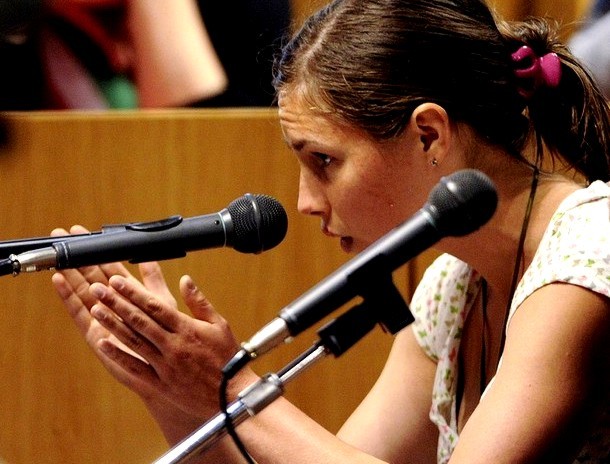
Wednesday, November 27, 2013
Amanda Knox Lies Again To Get Herself Into Another European Court “But Really, Judge, Its Only PR”
Posted by Kermit
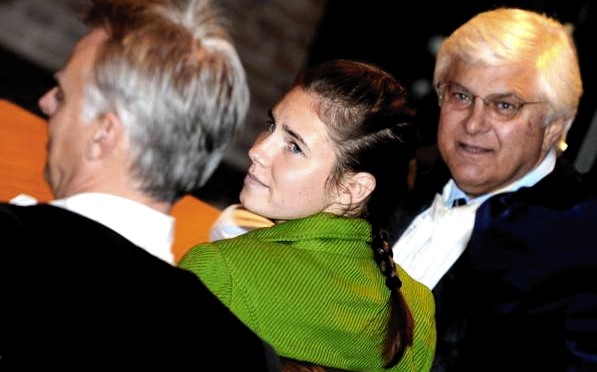
[Amanda Knox’s lawyer Luciano Ghirga (right): “Amanda wasn’t hit, we made no complaint”]
Introduction
This is the first of two posts on Knox’s claim to have sent an appeal to the Strasbourg-based European Court of Human Rights (ECHR).
Last Monday the main event that followers of the Meredith Kercher murder case were awaiting was the closing argument by Prosecutor Alessandro Crini in Amanda Knox’s and Raffaele Sollecito’s appeal trial.
Dr Crini’s structuring of the prosecution’s case in 16 points demolished the defendants’ efforts to present the volume of evidence against them as an incredible, long series of mistakes, coincidences and misunderstandings.
It seems, however, that Amanda Knox and her people didn’t want the public to be too fascinated by Dr Crini’s devastating argument. They really wanted them to be distracted by what can only be seen as an ill-judged public relations move, breaking yet more laws along the way.
Knox attempted to blow smoke over the prosecution’s arguments by grandly announcing “today, my lawyers filed an appeal of my slander[sic] conviction with the European Court of Human Rights.” That explanation of her PR ploy calls for a close review of her eligibility (here) and her so-called proof (next post).
Knox’s eligibility or otherwise
The European Court of Human Rights, is a supranational European tribunal dedicated to ““ as its name suggests - human rights.
It is not dedicated to criminal or civil proceedings on murder, sexual assault, theft, simulation of a crime, or any of the other charges that Knox faces.
In fact, to avoid the many unnecessary or spurious applications which hamper real cases getting attended to, the ECHR provides a number of online resources on who may apply and how and why.
One of the first issues that its advice underlines is that it is not a glorified appeals court:
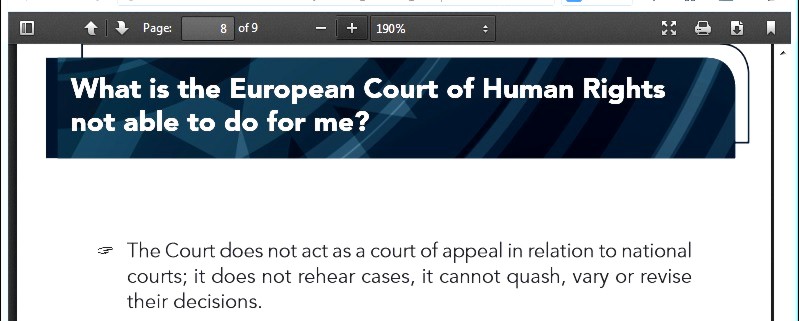
It is strange then, that Amanda Knox claims that her lawyers have “appealed” her case to the ECHR.
Either Knox’s legal advisors are just ignorant (which ones? The Italian professionals, or the American media hacks?) or this is simply a last-ditch Hail Mary action as an extradition request moves inexorably closer.
If the ECHR makes clear that it isn’t a court of appeal, there shouldn’t be any direct correlation between the Supreme Court confirming her as a convicted criminal and her application to the ECHR.
If that is in fact the basis of their application, it will not go far before rejection. In fact, the vast majority (more than 95%) of applications get rejected:
“For a number of years now, and owing to a variety of factors, the Court has been submerged by individual applications (over 130,000 were pending as at 31 August 2010). The overwhelming majority of these applications (more than 95%) are, however, rejected without being examined on the merits for failure to satisfy one of the admissibility criteria laid down by the Convention.
This situation is frustrating on two counts.
Firstly, as the Court is required to respond to each application, it is prevented from dealing within reasonable time-limits with those cases which warrant examination on the merits, without the public deriving any real benefit.
Secondly, tens of thousands of applicants inevitably have their claims rejected, often after years of waiting.”
It would be a outrageous if other, real human rights cases were delayed due to a Public Relations ruse as part of an extra-judicial strategy to undermine a request for Knox’s extradition.
Other ECHR on-line resources help potential applicants decide if they be eligible to be heard at the Court.
Below, a work-flow chart presents the main steps, including various “Admissibility Criteria”:
A first admissibility criterion
The first Admissibility criterion is that an applicant has exhausted “domestic remedies” in pursuing the recognition and correction of the human rights he or she feels have been abused.
Knox in her application to the ECHR directly relates the Italian Supreme Court final confirmation of her “calunnia” sentence (three years for obstruction of justice for framing her kindly boss Patrick Lumumba as the murderer of Meredith Kercher, thereby throwing off the course of the investigation) to her application to the ECHR.
But what were the supposed human rights abuses suffered? What did she do to remedy them?
The first requirement of exhausting “domestic remedies” means that the rights abuses that Knox alleges she has suffered have been pursued in Italy, and that all possible instances of reclamation in Italy have been visited.
However, as far as the public knows, Knox has not even placed a formal complaint concerning supposed civil rights abuse. Certainly her own Italian lawyers have said they havent.
The US and Italian publics would be interested in seeing her specific claims to the ECHR and whether there is any registration of such claims or complaints with the Italian police or other administrative or NGO offices.
Knox’s needling stepfather, Chris Mellas, stated in April 2008 on a precursor to the PMF discussion forum that a complaint had been filed concerning Amanda being hit during questioning.
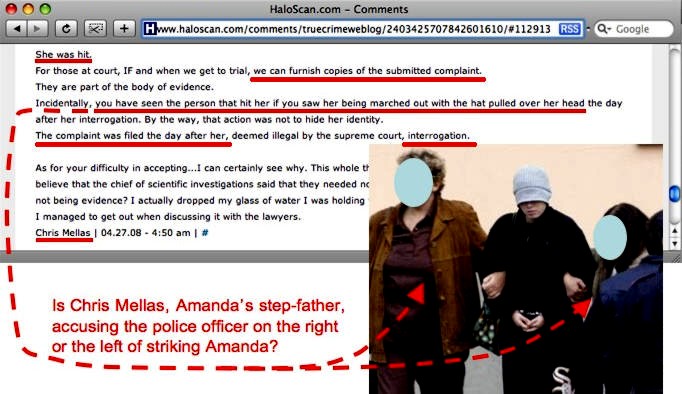
[Click for larger version]
However, nothing more has ever been heard of this complaint, which definitely would have been a starting point for pursuing domestic Italian remedies to the claimed rights abuse.
Since it appears zero rights abuses have been pursued in Italy, and the date of Knox’s application to the ECHR is in effect unrelated to her “calunnia” sentence confirmed by the Supreme Court, the six month limit beyond national remedies related to the rights abuse for applying to the ECHR is irrelevant here.
It should be noted that when Prosecutor Crini asked this week for an addition to Knox’s confirmed sentence for “calunnia”, adding another year to the three years already served by the convicted criminal, this is not a reopening of the “calunnia” case or an example of “double jeopardy”, but rather the reassessment on appeal of a separate, pending issue related to the basic calunnia charge: whether it should include an additional year of sentence for being aggravated.
Since this aggravation addition to the charge is awaiting determination, and follows from instructions of the Italian Supreme Court (and could result in an additional year in prison), it is not part of the prior, confirmed sentence.
A second admissibility criterion
Now just in case Knox or her lawyers would like to allege any perceived human rights abuse whatsoever in their ECHR application, the Strasbourg court insists on the reclamation in question being directly related to one of the sections of the European Convention on Human Rights
I’ve gone through it and I see chapters related to illegal detention (detention permitted only following arrest) and torture, but nothing related to getting cuffed on the back of your head.
If such an event ever occurred, it shouldn’t have, but quite likely one of the other authorities or rights bodies listed by the ECHR may be better equipped to deal with it.
This is a second Admissibility Criterion that filters out many applications: one can’t simply run to the ECHR saying “my rights have been abused” ““ the issue at hand must be directly related to the European Convention on Human Rights.
I seriously doubt the “hitting” event ever occurred because Knox’s own Italian lawyer Luciano Ghirga denied it, stating to the Press on 21 October 2008:
Amanda wasn’t hit. There were pressures fom the police, sure, but we never said she was hit.
As our next post here on this same subject will show, even Knox herself admitted she was treated well.
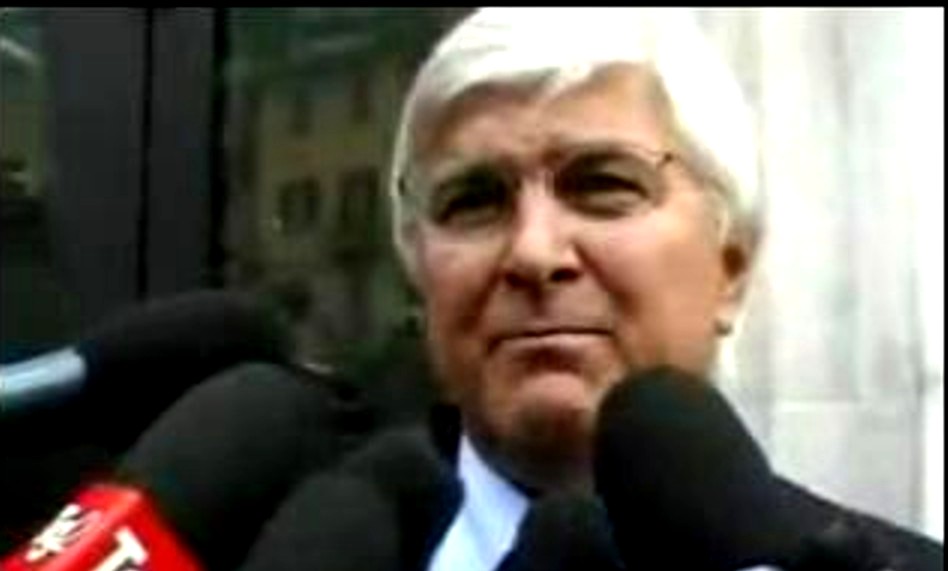
[Above: Amanda Knox’s Italian courtroom lawyer stating to the Press in 2008 that she had not been hit.]
If Knox hasn’t even tried to remedy being allegedly hit in Italy by suing or making formal complaints, nevertheless the Italian police certainly have acted upon such suggestions.
A number of legal processes are under way against Knox and her family members for slander and calunnia. Knox might face two more charges of aggravated calunnia. Why do I doubt that Knox has even mentioned those other legal processes in her application to the ECHR?
Those charges would of course have to be taken care of (as part of “exhausting domestic remedies”) before the ECHR would be able to consider her application, assuming it surmounted all of its other shortcomings to get to the ECHR judges’ hands.
A third admissibility criterion
Another Admissibility Criteria is the “Significant Disadvantage” filter. If an alleged rights abuse is minimal ““ compared to the very serious issues that the ECHR was created to consider ““ the application will go no further.
The only violent description of Knox’s alleged beating was given by her stepfather, Chris Mellas: “She was interrogated, and hit, and threatened,” he typed. “Tortured. Physically and mentally”.
However, there was never any medical or forensic notification of such “torture” before or after her incarceration in Capanne Prison.
Rather, Knox spent her time in prison receiving regular visits from a lovelorn Italian politician who befriended her, and participating in prison musical and theatrical activities.
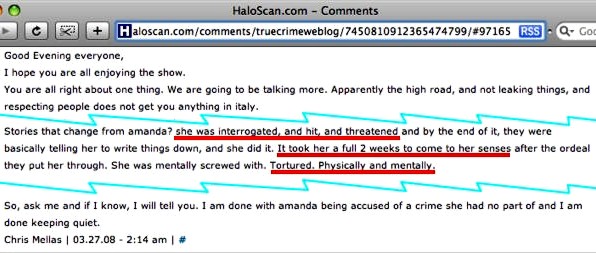
[Click for larger version]
In underlying the “significant disadvantage” requirement, the ECHR states in its examples of rejected claims, that it can’t be distracted by the French driver who lost a point on his driver’s licence, or the Romanian who claims 90 euros from the State, when the Court has real and serious Human Rights cases to deal with such as:
- El-Masri v. the former Yugoslav Republic of Macedonia (Article 3 of European Convention on Human Rights: Torture and inhuman and degrading treatment during and following applicant’s extraordinary rendition to CIA)
- Hirsii Jamaa and others v. Italy (Article 4 of Protocol No. 4: Return of migrants intercepted on the high seas to country of departure)
It’s almost certain that Knox has not pursued on an Italian level any remedies to her alleged human rights abuse (whatever it was), nor is there any evidence that the investigation into Meredith Kercher’s murder and the subsequent trials of Knox, Rudy Guede and Raffaele Sollecito were affected in their outcome by the rights abuse.
This is especially the case if the limit of Knox’s human rights suffering is that described by a talky ex-FBI helicopter pilot turned ex-college security guy turned Amanda Knox groupie, Steve Moore.
Moore describes the “frightful” circumstances of Knox’s witness questioning on the night of 5 November 2007 for the couple of hours (perhaps even somewhat less) that it lasted:
No food, no coffee, no bathroom breaks ““ nothing.
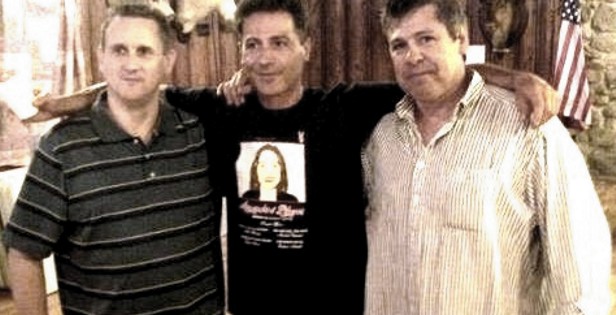
Above is ex-college security man Steve Moore, right, together with PR flunkie Bruce Fischer, left, both flanking “Frank Sfarzo”, a Knox-Mellas family friend.
Francesco Sforza is currently a fugitive from the Seattle courts on two counts of Assault-Domestic Violence, who continues to support Amanda in ongoing Internet blog posts, from wherever he may be.
See below. Click for larger. In purple, my corrections to Knox’s “what-I-want-the-World-to-believe” post about applying to the ECHR.
In conclusion
Between the manifest doubtfulness of the acceptability of Knox’s application to the European Court of Human Rights, on one hand, and the falsehoods and half-truths in her announcement, on the other, why do I get the feeling that the only reason and hope she and her team have in announcing the application (whether really filed or not) is to distract the attention of the followers of her appeal trial from the prosecution’s weighty arguments?
This will have little if any effect on the wheels of Italian Justice, and probably even less on a State Department more concerned with maintaining good relations with European allies while diplomatic challenges occur in the Middle East and Asia, than with a lobby plan to prevent Knox’s extradition.
[Below: The European Court of Human Rights in Strasbourg France]
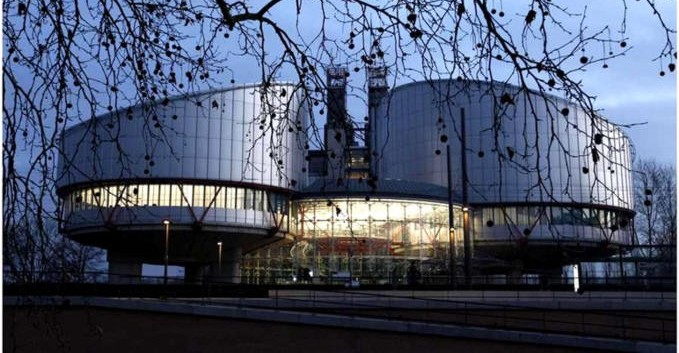
Sunday, November 10, 2013
The Crime-Scene Clean-Up: How Rudy Guede’s Diary Provides Even More Proof That It Happened
Posted by pat az
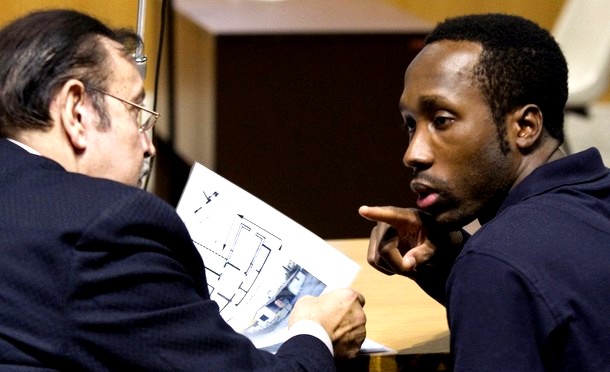
This post is crossposted from my own place. Here is one of my previous crime scene analyses on TJMK.
Rudy Guede was ultimately declared convicted by the Supreme Court in 2010 of participating in the 2007 murder of Meredith Kercher.
The prosecution claims the two other participants are Amanda Knox and Raffaele Sollecito. Knox and Sollecito are currently appealing their conviction of the same crime.
The case against the three of them involves a suspected clean up of the hallway in the apartment after the crime. Meredith’s blood was found in the bathroom, and half a footprint in her blood was found on the bathroom mat. However, there was no visible blood between Meredith’s bedroom and the bathroom.
The only visible blood in the hallway were faint partial shoe prints that led directly out the front door of the apartment.
After the murder was discovered, the media reported almost daily on developments in the case. The day of the murder, the press reported on the blood found in the bathroom and the bedroom.
But until police used luminol at the apartment on December 18th, the media didn’t report on any significant blood found in the hallway. Between November 2nd and December 18th, only one person stated that significant amounts of blood had been in the hallway.
Rudy Guede.
Rudy Guede actually wrote about it in his diary between Nov 20th and Dec 6th, after being captured in Germany.

The police arrived at the apartment on November 2nd. According to media reports, the blood they spotted immediately was only in the bathroom and Meredith’s bedroom. When the scene was more closely examined, after the discovery of the body, police found visible blood patterns on the floor left by Guede’s left shoe as he left the apartment.
None of the people who arrived in the apartment on the afternoon of November 2nd reported seeing them; these footprints are not in any of the stories of the events of Nov 2nd told by Amanda Knox nor Raffaele Sollecito. So, while these prints were visible, they were not substantially obvious.
On December 18th 2007 investigators applied Luminol in the hallway and other bedrooms. This forensic chemical is used to detect blood which has been cleaned away. The Luminol revealed several footprints in the hallway between the bedrooms of Knox and Meredith. Example below. Some of these footprints were leading towards Meredith’s door.
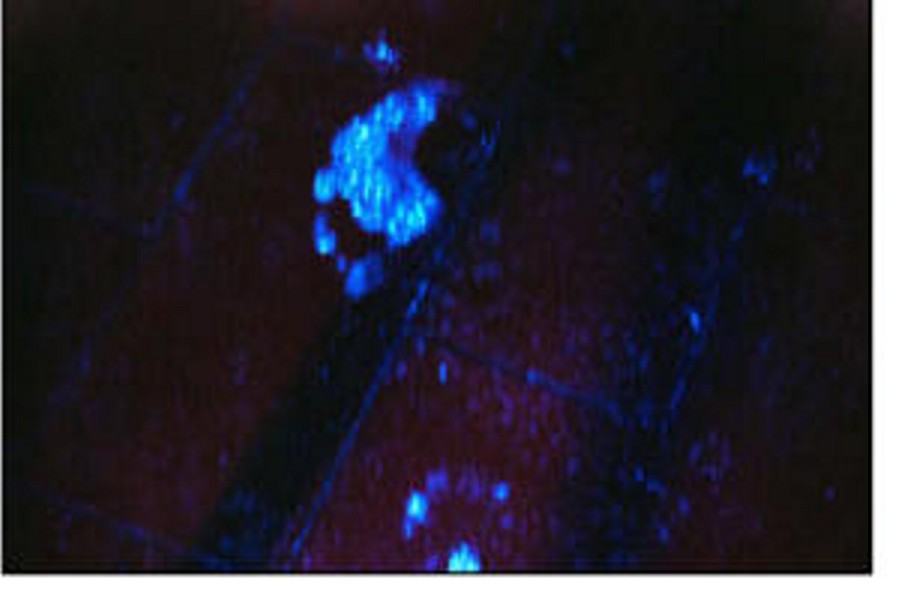
They also discovered prints in Filomena’s room which contained Meredith’s DNA and Amanda Knox’s DNA. They also revealed a footprint in Amanda Knox’s bedroom. (The defense unsuccessfully contested the investigator’s conclusions that these prints were made with blood).
On November 19 2007, an international arrest warrant was issued for Rudy Guede. He was arrested in Germany on November 20th. Guede remained in Germany until his extradition on December 3rd.
During his stay in jail in Germany, Guede wrote a long statement that was published and translated. Guede’s writings are similar to to Knox’s jail writings in many ways - they both try to write out their own detailed version of events, while pointing blame elsewhere.
But Guede’s comments may in fact be confirmation of a clean-up after the murder of Meredith Kercher (emphasis added):
I am asking myself how is it possible that Amanda could have slept in all that mess, and took a shower with all that blood in the bathroom and corridor? (Guede, Germany Diary, P21)
The police did not find evidence of any other blood until December 18th, AFTER Guede returned from Germany. As indicated above, the luminol revealed multiple footprints in the hallway, in Knox’s bedroom, and in Filomena’s bedroom. The image below shows these results in blue. Guede’s partial footprints are shown in red.
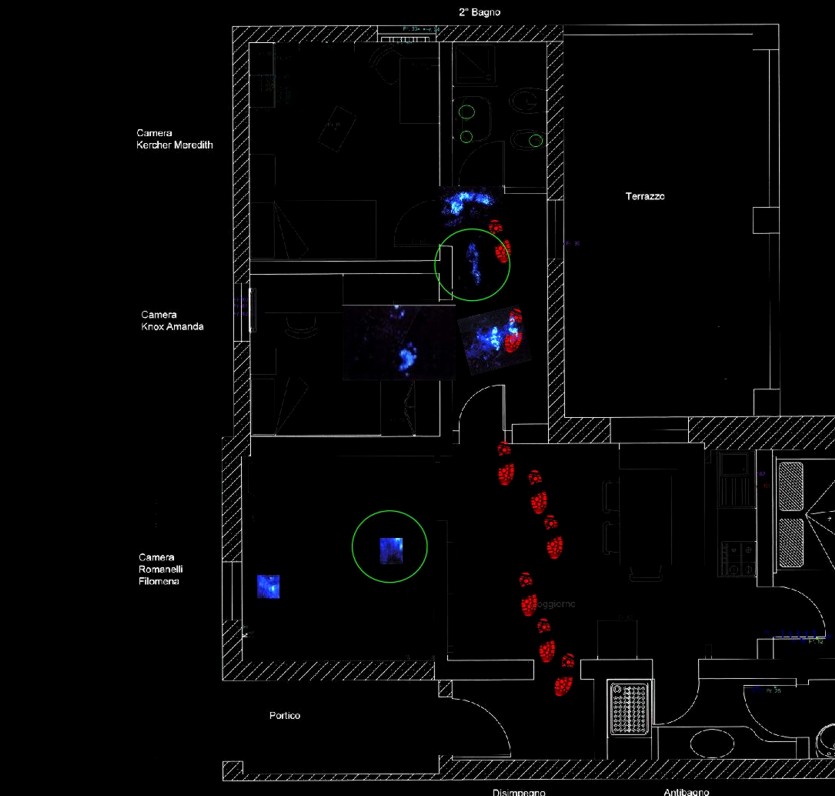
The conclusion is inescapable: Guede knew there would be significant evidence of blood in the hallway, before the police themselves found that evidence.
How did Guede know there would be more blood found in the hallway, before the police found that evidence on December 18th? And why wasn’t that blood there on the morning of November 2nd?
The courts believe the blood in the hallway was cleaned after the murder of Meredith Kercher. And the Micheli and Massei courts believed only one person had the motivation to hide this evidence: Amanda Knox.
Here is a summary of Judge Micheli’s October 2008 indictment finding.
In Judge Massei’s December 2009 trial finding for the original conviction of Knox and Sollecito, he also writes about the clean-up that the judges believed to have happened:
Further confirmation is constituted by the fact that, after Meredith’s murder, it is clear that some traces were definitely eliminated, a cleaning activity was certainly carried out. In fact, the bare foot which, stained with blood, left its footprint on the sky-blue mat in the bathroom, could only have reached that mat by taking steps which should have left other footprints on the floor, also marked out in blood just like (in fact, most likely, with even more [blood], since they were created before the footprint printed on the mat) the one found on the mat itself. Of such other very visible footprints of a bloody bare foot, on the contrary, there is no trace. (Massei, Dec 09; PMF translation)
In defense of Guede, Knox, and Sollecito, some might try to claim that Guede heard about blood in the hallway in the news. Rudy Guede was arrested 18 days following the murder of Meredith Kercher. During that time he had access to read the news and watch reports.
I have searched for articles in the period between November 2nd and December 18 which mention blood. All of the articles I have found so far discuss blood in the bedroom or the bathroom. One or two discuss footprints leading to the front door.
None of them discuss blood in the hallway that would justify a statement from Guede of “tutto quel sangue nel bagno e sul corridoghe” (all that blood in the bathroom and in the corridor)
Guede himself said he went between the bedroom and the bathroom, so may have tracked blood into the bathroom and therefore known blood would be found in the hallway.
Even that knowledge however confirms a clean-up, as there was not a trail of blood between the bathroom and Meredith’s room that justifies the footprint on the bathmat and blood found in the bathroom.
I have my own questions as a result of Guede’s knowledge of blood in the hallway:
Could the attack have started in the hallway? Could the first blood shed have been on the hallway tiles?
The prosecution and courts argue that Amanda Knox had a role in the attack and murder. Knox and her supporters are very adamant that there is no trace of Knox in Meredith’s bedroom. While the courts argue otherwise, could Knox’s role have been limited to the hallway?
Sadly, we may never know the full truth of what happened on the evening of November 1st, 2007.
My timeline of media reports on blood
- Nov 2nd: Meredith Kercher found. Blood found in bathroom.
- Nov 5th: Police analyzing traces of blood from apartment below.
- Nov 5th: A “trail of blood” is on the inside handle of the door to the apartment.
- Nov 7th: reports of Amanda Knox’s statements, includes finding blood in the bathroom.
- Nov 14th: Police use of Luminol at Sollectio’s house. First reports on the knife seized by police from Sollecito’s house.
- Nov 19th: Analysis of blood in bedroom (pillow, bra, etc).
- Nov 22nd: Guede’s prints in blood.
- Nov 27th: Amanda Knox’s blood on bathroom tap.
- Nov 28th: Blood in bathroom.
- Dec 5th: Reports of Guede’s letter to father: “there was so much blood”.
My timeline of main events involving Guede
- Nov 2nd, 2am ““ 4:30 am: Guede seen by witnesses at Domus nightclub.
- Nov 3: Guede leaves Perugia for Germany
- Nov 11: Guede’s cell phone tracked in Milan (Corriere)
- Nov 12: Newspaper reports a 4th suspect.
- Nov 19: Guede identified as suspect in newspapers
- Nov 19: Guede skype conversation with friend.
- Nov 20: Patrick released from prison.
- Nov 20: Guede arrested while trying to return to italy on train in Germany.
- Nov 21: Guede interrogated by German police; Guede admits to being at apartment, blames an italian man for murder.
- Nov 20-Dec 5: Guede writes diary in German prison.
- Dec 3: Germany grants Guede’s extradition back to Italy.
- Dec 6: Guede returns to Perugia.
- Dec 7: Guede interrogated by Magistrate.
- Dec 14: Guede ordered to remain in prison.
- Dec 17: Knox is questioned by Mignini.
- Dec 18: Police use luminol in apartment and find footprints in hallway and in Filomena’s bedroom.
Thursday, October 17, 2013
When You Get In A Deeeep Hole, Best To Stop Digging: Did Anyone Think To Tell Knox?
Posted by James Higham

[Florence courts in winter; how they might look when the appeal verdict comes down]
Not sure the Knox machine quite understands what trouble their charge is in.
She’s already done three years for calumny and is at it again. Her recent slurs on Italian courts and the police have brought further litigation down on her head.
Then there is the little matter of the court award to Patrick Lumumba for false accusation of murder, which she has not paid to this day, despite earning huge amounts from her fiction work published in America. Every one of us knows what happens when we default.
See how this stands up as her reason not to pay up:
I have already appealed to him to tell him that I didn’t go to the Police Headquarters with the aim of accusing him of a murder he did not commit. What was dragged out of me was dragged out from me without my wanting to harm him.
I only wanted to help and I was completely confused so that I didn’t know what was true and what was not true at that point. Therefore I didn’t want to harm him. I “¦ (MAXI-SIGH) “¦ His.. His name came out only because my mobile phone was there and we exchanged some SMS.
She says: “Vorrei che lui [Patrick]può capire in che situazione io mio trovavo.” I’d like him to understand the situation I’m in. Pardon? A man wrongfully banged-up in prison and owed $80 000 by her should understand the situation she is in?
She was asked what happened and answered, “My best truth is “¦” My best truth? She invented an entire situation with Mignini which simply did not happen according to eyewitnesses, including her translator. Simply did not occur that way. She volunteered a statement but in the light of subsequent events weeks later, changes that, upon advice, to her being browbeaten.
Hence the calumny charges.
Main poster Stilicho adds:
Knox can’t even be honest about her time in prison. She was not in prison because she was wrongly convicted for murder but because of the calunnia she committed against Patrick and as a precaution against her fleeing the country or killing someone else before her trial was completed. She sang and danced and was frequently visited by politicians and other dignitaries. By all accounts, it was the most productive time in her life.
When confronted with her lies, she says, “I was confused.” Sorry ““ courts don’t buy such things. They deal in truth or non-truth. None of this “it seemed to me”. She interprets this real-world reaction as hurtful, hateful to Amanda.
In short, she appears to be emotionally or socially retarded, not fully understanding what she has got herself into. Should she be released on a technicality, as Casey Anthony was, she still faces years inside because of the libel and slander which is piling up. Her own people are also being litigated. Peter Quennell:
We don’t see any sign that David Marriott or Robert Barnett or Ted Simon have the slightest clue about Italian law. They are all liable too for the felonies in the book and all of them could be charged too by the Bergamo judge.
Her advisors need to shut her up before she makes it any worse for herself. In that accusation of Lumumba, she said she was there, in the next room with her hands over her ears because she couldn’t bear Meredith’s screams. It was a clear description, clear enough for the police to arrest Lumumba and put him in prison. The screams coincided with those the neighbours reported.
If one was to substitute Guede and Sollecito, whose bloodied footprint was on the bathmat, for Lumumba, that might be close to the truth of what happened, it would explain no DNA found of hers in the actual room..
Except that there are multiple mixed blood traces and her DNA twice now on the murder weapon, along with her panicked reaction when the cutlery drawer was opened, plus her words to her mother that they’d found a knife and that she was very worried about it. Why would she need to worry if she wasn’t there?
She might be able to explain away the pattern of where her DNA was found on the knife ““ a stabbing grip near the blade ““ as a weird way of cutting vegetables. Then there was Sollecito’s admission over Meredith’s DNA in the scratch as an accident when he pricked Meredith in the hand whilst cooking at his place.
Except Meredith had never been to his place. And he still maintains that Knox was not with him that evening at his own home.
So, despite the sweeping statements by her minders of “no evidence”, which are then syndicated all over the world by their media entourage, inc the Wail, there’s actually copious evidence. After you get past the conflicting stories, the cellphone activity and the witness identifications, there is still the matter of the mixed blood traces.
There was no blood the night before, by Knox’s own admission. Meredith was out that early evening, the two had not been together. These are the sorts of minor anomalies she can only explain with “it seemed to me” or “I imagined”.
Then there is the little matter of the hand marks on the neck, too small for the men although there were other marks too.
The horror for Amanda Knox, in her infantilized state ““ look at her handwriting ““ is that she cannot see consequences, not unlike a child. She doesn’t understand that you can’t go killing someone and get away with it. She’s constantly on about being seen as a good person, as every child and every adult would like and so many of us do not see it that way.
Like a child, she just wants it all to go away and that childlike appearance is what strongly drags in most people’s sympathy ““ here is a State and nasty people worldwide being cruel and mean to a young innocent. Yet she’s getting on for 30 now and is no child. And she still spreads the libel with no thought of consequences, just as she saw no consequences on that night, just the there and then.
The role of drugs cannot be downplayed in this effect on her mind. She’s almost a poster girl for today’s youth and the early sex and drugs, with the dumbing-down at school at the same time.
She’s a mess and it’s hard not to sympathize with that and want help for her “¦ except for one pesky problem. She’s a convicted murderess.
The reaction to these posts will be sympathy for her and anger at the bully who is writing it. It should actually be disgust at what she did and neutrality towards the reporter writing the post. How does it shift from one to the other?
Natural chivalry. Yet in this sympathy for her, there is still the question of her victim choking on her blood once the screams had stopped. And that is what maintains our interest in the case ““ it is unresolved as yet, it is close to the end.
She might get off on a technicality if her lawyers are good enough. She’ll then go into that limbo state of Casey Anthony and all the other broken children of today, the blame for which many of us lay at the door of Them and their narrative.
For sure there is a sadness to it, which a new commenter, David Berlin mentions:
Knox is a hamster on a wheel, in a cage, endlessly condemned to repeating the same nonsense. In an earlier post I saw her as a character in Beckett’s “˜Play’ and the more she opines the more apt that seems. Endlessly repeating a story, fixed in her lines, unable to find an exit.
Commenter Goodlife writes:
Her life now does not seem all that different from her days in prison in that most aspects of her life seem to be under the control of someone else. But does anyone believe that she is any happier or more content now? She is now nothing more than a performing monkey, dishing out the script given to her by her supposed nearest and dearest.
An Italian commented: “Young Italian actors should learn from Amanda Knox. She is a great actress.”
She’d stare at that comment in horror. She uses the term bambina for herself, rather than ragazza, sheltering within this childlike status. At 20. At nearer 30 she is still doing it. She said in an interview that she was la più piccola [the littlest] instead of la più giovane [the youngest]. Littlest evokes more sympathy.
She’s in a prison of her mother’s and her estranged father’s making.
She’s caught up in an international horror story and she’s the leading player. This will always garner sympathy.
She asks why everyone hates her. They don’t hate her ““ that’s child talk. They are appalled by the machine she has behind her and their antics and believe she should take responsibility and start paying off the debt to the dead girl.
Meredith by name.
Tuesday, October 08, 2013
Questions For Knox and Sollecito: Why Claim Rudy Guede Did It Alone When So Much Proof Against?
Posted by Marcello
1. Problems Of Your “Guede did it alone” Mantra
Your attempts to frame Guede for the entire attack sound racist, and they fly in the face of a multitude of hard facts.
Why are you and your more untethered supporters arguing to the media that Rudy Guede alone attacked Meredith (he could not have), that he was a drifter (he wasnt), a burglar (he wasnt), and drug dealer (he wasnt), and that his DNA traces are “all over Meredith’s room” (they werent)?
There are surprisingly few DNA traces of Guede in there, and outside Meredith’s door there is only evidence of (1) his prior use of the south bathroom, and (2) his shoeprints headed straight for the front door.
There is zero evidence that Rudy Guede was ever in the shared bathroom (the one with Sollectio’s bloody footprint on the bathmat) and zero evidence he was in Filomena’s room (the one with the broken window and the mixed DNA of Meredith and Knox).
2. Evidence Against You Is Far, Far Stronger
Explain if you can about Sollecito’s bloody footprint. Explain if you can about the evidence of cleanup. Explain this and this about your multiple contradictory alibis.
Explain if you can why YOUR own witnesses Alessi and Aviello were such disasters for your side in court. Explain your cell phone actions (or non-actions) and the timing and content of your phone calls, and your computer actions (or non actions).
Explain why in Sollecito’s book he claims he sent several emails throughout the night; but there zero records of such emails with his email provider. Explain why both Sollecito and Knox framed Dr Mignini.
There are three compelling reasons above all why the Massei court and the Supreme Court will remain totally unbending on the point that Guede did NOT attack Meredith alone, and that it had to be a pack attack on Meredith.
- One is the full day of closed court testimony at trial by crime-scene experts from Rome who accounted for every point of evidence in Meredith’s room with a depiction of a 15 minute pack attack involving three people. This seriously upset the jury and your own defense was left essentially speechless.
- One is the prosecution’s video shown in closed court during Summations of the recreation of the attack on Meredith, which accounted for every point of evidence with a 15 minute pack attack involving three people. This seriously upset the jury and your own defense was left essentially speechless .
- One is that the entry of an attacker via Filomena’s room is so absolutely unbelievable. Your own defense always knew this, and barely tried to make that sale (hence the witnesses Alessi and Aviello).
There are seven other routes for a burglar to enter the house, all of them faster and quieter and five of them darker. You can see five in these images below: two via the east windows, three up onto the balcony and into the house via the louvre door or the kitchen window.
All seven routes would be obvious to any burglar, long before he walked all the way around the base of the house to beneath Filomena’s window (which he did several times in your scenario).
3. The Numerous Questions From Which You Hide
On or after 6 November you have both promised to appear in the appeal court in Florence. You are apparently too nervous to face cross-examination under oath, but you have said you intend to try to explain things.
- 1) Rudy Guede had been to the apartment at least twice already on prior occasions and knew the boys who lived in the lower story. Why did Guede choose to NOT break-in to the lower story where he knew (or could ascertain) that all four boys were away on holiday, and therefore could break-in and rummage with some certainty of not getting caught?
2) Why did Guede choose to break-in to the upper story of the villa mid-evening, when he surely knew Knox and Kercher would be staying at the villa for the holidays and could have been there or returned at any time to “catch him in-the-act”?
3) Surely Guede would have verified that no one was present by circling the cottage and checking if any lights were on in the windows? But Guede “missed” the really easy way in: the balcony in the dark at the rear, used in 2 burglaries in 2009.
4) If Guede did circle the cottage to make sure no one was there before attempting the break-in, why would he then choose the most visible and more difficult path of entry through a second story window, as opposed to the more hidden and easier path of break-in at the back of the villa, which he would have noticed while circling the villa?
5) Why would Guede choose to break-in through a second story window that was highly exposed to the headlights of passing cars on the street as well as exposed to night lighting from the carpark?
6) Ms. Romanelli testified that she had nearly closed the exterior shutters. Assuming her memory is correct, there is no way a burglar could easily verify if the windows were latched and if the inner scuri were latched to the window panes, which would make access to the window latch impractical unless one was armed with a core drill or an ax. Why would Guede, who was certainly familiar with such windows, choose to attempt the break-in through a window that he could not easily verify would allow him quick access?
7) Assuming the shutters were closed, Guede would have to climb up the wall and open the shutters before smashing the window with the rock. The night of the murder, the grass was wet from rain the previous day. Why was there no evidence of disturbed grass or mud on the walls?
8) Guede had Nike sneakers, not rock climbing shoes. How did he manage the climb up the wall with that type of footwear?
9) If the shutters were closed, or somewhat closed, how did Guede manage to lift himself up to the sill with only an inch of sill available to grab onto?
10) Assuming Guede opened the shutters, how did Guede verify if the inner scuri where not latched to the window panes, which would prevent access to the window latch? There was no light inside Ms. Romanelli’s room to reveal that the scuri were ajar.
11) Assuming Guede managed to check that the inner scuro behind the right-hand window was not latched, how did he manage to break the glass with a 9 lb rock with one hand while hanging on to the sill with the other?
12) Assuming Guede managed check that the right-hand inner scuro was not latched, how did he break the glass with the rock without having glass shards fly into his face?
13) If Guede climbed down to the lob the 9 lb rock at the window from 3 meters below, how would he do so to avoid glass shards raining down on him?
14) If Guede climbed down to the lob the rock at the window from below, why would he choose a 9 lb 20 cm wide rock to lob up to a window 3 meters above him, with little chance of striking the window in the correct fashion?
15) If Guede climbed down again and climbed back up to the carpark (up a steep slope with slippery wet grass and weeds) to lob the 9 lb 20 cm wide rock from the car park, why is there no evidence of this second climb down on the walls?
16) Why did Guede choose a 9 lb 20 cm wide rock to throw from the car park, given that a large, heavy rock would be difficult to lob with any precision? Especially considering that the width of the glass in the window pane is only 28 cm wide, surely anyone, experienced or not, would have chosen a smaller, lighter rock to throw with greater precision.
17) If Guede lobbed a 9 lb 20 cm rock from the car park, such a lob would require some velocity and therefore force. Guede would have been roughly 11-12 feet away from the window, in order for the lob to clear the wood railing at the carpark. If the rock was thrown with some velocity, why is the upper 1/2 of the glass in the window pane intact, without any fracture cracks at all?
18) If Guede lobbed a 9 lb 20 cm rock from the car park, such a lob would require some velocity and therefore force. Why is there so little damage to the scuro the rock hit, so little damage to the terrazzo flooring impacted by the rock, and so little damage to the rock itself, which surely would have fractured more on impact with a hard terrazzo floor?
19) Why was there no evidence of glass shards found in the grass below the window?
20) If Guede climbed the wall to open the shutters, climbed down and up to the car park to throw the rock, then climbed back down and up again to the window, how does he manage to hoist himself onto the sill without cutting himself on the glass that was found on the sill?
21) If Guede climbed the wall to open the shutters, hoisted himself onto the sill, tapped the glass with a 9 lb rock to lightly break the glass in a manner more consistent with how the window was broken, why did he throw the rock into the room, rather than let it fall into the grass below?
22) Why was no dirt, grass, muddy shoeprints or similar trace evidence found on the window sill?
23) Why was no dirt, grass, muddy shoeprints or similar trace evidence found in Romanelli’s room?
24) If Guede climbed the wall to open the shutters, climbed down and up to the car park to throw the rock, then climbed back down and up again to the window again, hoisted himself onto the sill without cutting himself on the glass that was found on the sill, unlatched the window and stepped inside Filomena’s room, how did he manage to get glass on top of Romanelli’s clothing that was found under the window sill?
25) Why would Guede, who would have spent a good 10 minutes trying to break and enter with the climbing up and down from the carpark, waste valuable time throwing clothes from the closet? Why not simply open the closet doors and rifle through the clothes without creating more of mess?
26) Why did he disregard Romanelli’s laptop, which was in plain view?
27) Why did Guede check the closet before checking the drawers of the nightstand, where surely more valuable objects like jewelry would be found?
28) Why were none of the other rooms disturbed during the break-in?
29) Assuming Ms. Kercher arrived to the cottage after Guede’s break-in, presumably when Guede was in the bathroom, why did she not notice the break-in, call the police and run out of the cottage?
30) Assuming Guede was in the bathroom when Ms. Kercher returned, why go to the extent of attacking Ms. Kercher in her room rather than try to sneak out the front door, or through the window he had just broken, to avoid if not identification, at least more serious criminal charges?
31) Assuming Ms. Kercher was at the cottage while Guede broke-in, why did she not call the police the moment she heard the rock crash through the glass, loudly thud to the terrazzo floor and investigate what was happening in Romanelli’s room while Guede was climbing back down from the car park and climbing back up to the window?
32) Assuming Ms. Kercher was at the cottage while Guede broke-in, Guede could have been on the sill already because he had tapped the glass with the 9 lb rock to break it. Therefore perhaps Guede was already partially inside Romanelli’s room when he was discovered by Ms. Kercher. In this case Guede follows Ms. Kercher to her room in an attempt to dissuade her from calling the police and the assault ensues. But then, if this scenario is correct, when does Guede have time to rifle through Romanelli’s clothing and effects?
33) Why is there a luminol revealed footprint in Romanelli’s room that has mixed traces of Knox’s and Kercher’s DNA ?
34) Why does this footprint not match Guede’s foot size?
35) If multiple attackers were required to restain Ms. Kercher, holding her limbs while brandishing two knives and committing sexual violence, then who else was with Guede and why no traces of this 4th (or more) person(s) were found, either in shoeprints, footprints, fingerprints, DNA or otherwise?
36) If Guede and others were involved in the assault, why has Guede not acknolwedged them, and instead consistently hinted that, and finally admitting that Sollecito and Knox were with him during the assault?
37) If Guede and others were involved in the assault, why do the other shoeprints, footprints, DNA traces and fingerprints all point to Knox and Sollecito being present during the assault, in one way or another?
4. Italy Is Not Buying The Racist Mantra
If your racist mantra remains “the black guy did it alone” and “Italians are corrupt and stupid” you need to PROVE that. If you cannot answer all of these questions above, this will deservedly cook you.
You could be facing 30 years with the “mitigating factors” canceled and the new penalties you will incur for your dishonest books and PR campaigns.
[Five easier ways in: 3 via balcony (note two drainpipes, window grid below), 2 via side windows]

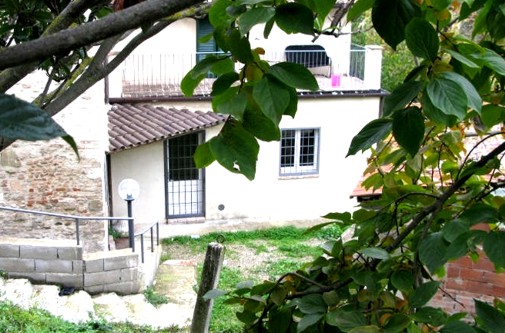
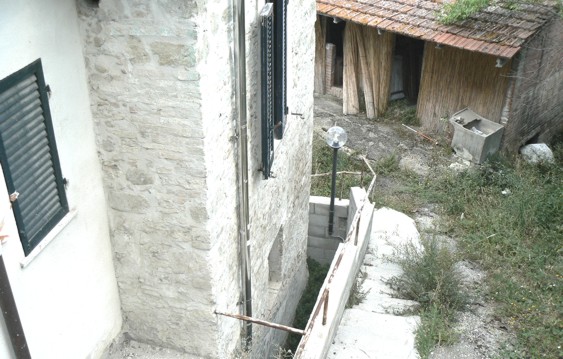
Wednesday, September 25, 2013
Why Numerous Psychologists Now Observe Knox Skeptically
Posted by SeekingUnderstanding
Links to both ITV interviews kindly provided by Clander of PMF: Daybreak Seattle interview and Daybreak London interview.
Please see the key past posts here and here and also here for some context.
Amanda Knox appeared in an English TV interview on the early morning of Monday September 23rd.
She spoke from Seattle to a detached ITV reporter in Seattle and a tough Daybreak anchor in London - tough. though she badly lacked second questions in follow-up. The interview was, by all accounts, fair, and also duly respectful towards Meredith’s family, who are in England.
But the girl or woman who is Amanda Knox we observed was neither calm nor happy.
There was not one authentic smile, and not a moment when the light came into her eyes. Her hair and make-up looked good - her presentation had been considered. But her skin was not well. As most women know, the skin, especially on the face, reveals your inner health, your inner peace.
As a psychologist, one is trained to distinguish ‘signs’, if you like, or indicators that illustrate the most crucial factors about the state of mind. One is taught to look beyond presentation and image, and too, beyond the actual words delivered, to hear what is actually being said - from the inner self or true self. Some people might prefer to use the term ‘the soul’.
What I heard in this interview is a person struggling and deeply disturbed and unhappy. I saw someone genuinely very afraid with strong feelings of hopelessness. Anger, defiance, and combativeness also showed.
But, newly, there were also signs of weariness with the self-elected fight. I believe Amanda is intelligent enough to realize that the weight and strength of the factual, combined evidence is stacked against her. Knowing this, as I believe she does, can only put her in an anguished state.
At times, one could plainly observe that a pre-rehearsed ‘PR’ line was being delivered. Amanda was being ‘a good girl’, and doing what she had been told. Examples seem to be especially where she says such things as, “I am innocent”, “my innocence has been proven”, ‘...this case is not complicated..”
Since, by applying a little elemental logic, most of these statements can be shown to be untrue, they unfortunately sounded somewhat like mantras being delivered. Rather more that these were the things AK would LIKE to believe are true. As if perhaps, if she closes her eyes often enough and wishes hard enough, they might become true…and her nightmare would now be over.
But, alas, childish unreality cannot last. We live in a world where we are required to become adults, and to act responsibly as adults.
At junctions in the interview, where some of the more penetrating questions were asked involving human relations, an ‘inner adult’ Amanda could be seen trying to emerge. One point was where she was asked about what she would do if found finally guilty.
A burgeoning sense of realism could be detected in her reply. She knows herself in this respect: she would find it unbearable to try and live as a fugitive in the free world, labeled as a murderer and a slanderer. She actually said so, with strength of feeling. It is people’s hatred of her that she can’t bear, and it is that she is protesting about so much. And indeed it must be hard to bear.
The interviewer, Lorraine, spoke at length about the Kercher family, asking AK what she would like to say to them. When Amanda replied, also at length, she said,
“... I would like them to give me a chance…”
This sounded authentic to me, I felt she meant it. However, she added to this, sounding almost like an addendum, that she wanted them to believe she could be innocent. This latter phrase, added in a different voice and intonation, didn’t ring true to my ears.
I believe that what is truly in her heart is that she longs, beyond all measure, for the Kercher family not to totally hate her. (She gives the impression that she believes they do or could hate her). She seems to truly not to be able to bear the thought of being hated, and even more unbearable, the thought that by her behaviour (as a ‘kid’) perhaps, just maybe, she might deserve that hate.
This would seem to be the source of her anguish, and also behind many other of her statements in this interview.
There would be a way through for her - a third way. This would be to start telling the truth, the whole truth, now. It is never too late to speak the truth, and it is never too early, either. The truth endures. This is a fact of history.
It would indeed take enormous courage for Amanda to take this step. It would be immensely difficult for her because of the PR campaign. But if she could begin to answer the outstanding unresolved questions, factually and honestly (unembroidered and not exaggerated), - she would, I believe, begin to heal her life, if this is genuinely what she wants.
She might be surprised at how much forgiveness there might be if she were to find the courage within herself to take this huge step. She quoted her priest/mentor from the Italian jail, when he advised her about how, at challenging times, we can find unknown resources and strength within ourselves that maybe we didn’t know we had.
She has a choice, and she could choose to do it. Making wise choices is what adults do.
Sunday, September 22, 2013
Questions For Knox: Ten Hard Questions That Knox Should Be Asked Monday On ITV’s Daybreak
Posted by The Machine

Amanda Knox will be interviewed for the first time in Britain on ITV’s Daybreak programme tomorrow.
No interviewer should unquestioningly accept everything Knox says as the gospel truth. Remember Knox served three years in prison and is labeled a convicted felon for life for malicious lying.
So let’s hope tomorrow’s interview is not yet another whiny mis-statement of the core facts, and not yet more sliming of Italian officials, of which we have just seen so many.
There are many questions on this site which Knox has never ever answered. Some arise from the evidence and some from her dishonest book.
See especially the tough questions here and here and here and here. With luck the Daybreak hosts will ask Knox all of these tough questions below.
1. Multiple false alibis
You and Raffaele Sollecito gave completely different accounts of where you were, who you were with and what you were doing on the night of the murder. Neither of you have credible alibis despite three attempts each. Sollecito told Kate Mansey from The Sunday Mirror that you and him were at a party.
He told the police that you and him were at his apartment. He then told them that he was home alone and that you weren’t at his apartment from around 9.00pm to about 1.00am. You first told the police that you were at Sollecito’s apartment. After you were informed that he was no longer providing you with an alibi, you repeatedly claimed that you went to the cottage with Diya Lumumba.
You changed your story yet again and claimed that you were at Sollecito’s apartment, but he might have gone out. All the other people who were questioned had one credible alibi that could be verified.
Extract of Sollecito’s witness statement.
“I went home, smoked a joint, and had dinner, but I don’t remember what I ate. At around eleven my father phoned me on the house phone. I remember Amanda wasn’t back yet. I surfed on the Internet for a couple of hours after my father’s phone call and I stopped only when Amanda came back, about one in the morning I think.
Question 1. Why did you and Raffaele Sollecito repeatedly tell the police and others a pack of lies?
2. False accusation
You falsely claimed that Diya Lumumba killed Meredith in two witness statements and you repeated the false accusation in your handwritten note to the police on 6 November 2007. You served three years in prison for this felony and your appeal to the Supreme Court was denied.
Question 2. Why did you repeatedly accuse Diya Lumumba of murder when you knew full well that he was completely innocent and why didn’t you or your mother retract your accusation when he was in prison?
3. The Double DNA Knife
According to a number of independent forensic experts - Dr. Patrizia Stefanoni, Dr. Renato Biondo, Professor, Giuesppe Novelli, Professor Francesca Torricelli, Luciano Garofano, Elizabeth Johnson and Greg Hampikian - Meredith’s Kercher’s DNA was found on the blade of a knife from Raffaele Sollecito’s kitchen.
He falsely claimed in his prison diary that he had accidentally pricked Meredith’s hand whilst cooking. Dr Stefanoni analysed the traces on the knife six days after last handling Meredith’s DNA. This means that contamination couldn’t have occurred in the laboratory.
Meredith had never been to Sollecito’s apartment, so contamination away from the laboratory was impossible.
Question 3. How do you think Meredith’s DNA got onto the blade of the kitchen knife?
4. The bra clasp
An abundant amount of Raffaele Sollecito’s DNA was found on Meredith’s on the exact part of Meredith bra clasp that was bent out of shape during the attack on her. His DNA was identified by two separate DNA tests. Of the 17 loci tested in the sample, Sollecito’s profile matched 17 out of 17. Professor Torricelli testified that it was unlikely the clasp was contaminated because there was a significant amount of Sollecito’s DNA on it.
Professor Novelli analysed the series of samples from all 255 items processed and found not a single instance of contamination, and ruled out as implausible that a contaminating agent could have been present just on one single result. David Balding, a Professor of Statistical Genetics at University College London, recently analysed the DNA evidence against Sollecito and concluded it was strong.
Question 4. How do you think Raffaele Sollecito’s DNA ended up on Meredith’s bra clasp?
5. The bloody footprint on the bathmat
According to two imprint experts - Rinaldi and Boemi - the bloody footprint on the blue bathmat in the bathroom matched the characteristics of Sollecito’s foot, but couldn’t possibly belong to Guede. Rudy Guede’s bloody footprints led straight out of Meredith’s room and out of the house which indicates that he didn’t go into the bathroom after Meredith had been stabbed.
See our past posts on this here and here.
Question 5. Who do you think left the bloody footprint on the bathmat?
6. Mixed samples of Amanda Knox’s DNA or blood and Meredith Kercher’s blood
According to the prosecution’s experts, there were five instances of your DNA or blood mixed with Meredith’s blood in three different locations in the cottage. Even your lawyers conceded that your blood had mingled with Meredith’s blood. In other words, Meredith and Amanda Knox were both bleeding at the same time.
Question 6. Why were you bleeding on the night of the murder and is it a coincidence that only your DNA was found mixed with Meredith’s blood?
7. The Luminol Enhanced Footprints
Bare bloody footprints were revealed by Luminol at the cottage. Three of them are compatible with your foot size and one of them is compatible with Raffaele Sollecito’s foot size.
Question 7. What do you think the Luminol was reacting to - Meredith’s blood or some other substance?
8. The staged break-in
There is absolutely no evidence that anyone stood outside Filomena’s window and climbed up the vertical wall on the night of the murder. There were no marks from soil, grass or rubber soles on the wall. The earth of the evening of 1 November 2007 was very wet, so if anybody had climbed the wall, they would have left some marks on it.
The glass on the window sill and on the floor show no signs of being touched after the window was broken, which would have been the case if the intruder had gained entry through the window.
There was not a single biological trace on any of the shards of glass. It would have been very likely that an intruder balancing on the window sill would have suffered some kind of injury or cut because of the shards of glass.
If the window had been broken from the outside, there would have been shards of glass outside, but there wasn’t even one.
Judge Massei and the panel of judges at the Italian Supreme Court specifically mentioned the shards of glass on top of Filomena’s clothes which had been tossed onto the floor in her room and regarded it as proof that the break-in was staged.
Question 8. Who do you think staged the break-in at the cottage?
9. Knowledge of the crime
Umbria Procurator General Galati’s pointed out in his appeal that you knew specific details of the crime that you could have only known if you had been present when Meredith was killed.
According to multiple witnesses at the police station, you said you were the one who had found Meredith’s body, that she was in the wardrobe, that she was covered by the quilt, that a foot was sticking out, that they had cut her throat and that there was blood everywhere. But you weren’t in a position to have seen anything at all when the door was kicked in.
In your witness statement you described Meredith’s scream. Other witnesses have corroborated your claim that there was a loud scream.
Question 9. How did you know so many precise details of the crime?
10. Shower and the “bathmat shuffle”
The Scientific Police found 13 traces of blood in the bathroom that Meredith and you shared. Prosecutor Mignini and Filomena have both expressed their surprise that you showered in a blood-spattered bathroom.
Filomena told Mignini during cross-examination: “I thought it was odd that she’d had a shower when there was blood all over the place.”
You told Mignini that you used the bathmat to shuffle to your room.
Question 10. Why did you shower in a bathroom that was splattered with blood, and did you notice the visible bloody footprint on the bathmat when you used it to shuffle to your room? And why so soon after did the police notice that you were stinking?
Lorraine Kelly and Aled Jones the ITV Daybreak hosts who should confront Amanda Knox

Thursday, September 05, 2013
Questions For Knox: Why So Many False Claims In Accounts Of Your Visit To The House?
Posted by James Raper
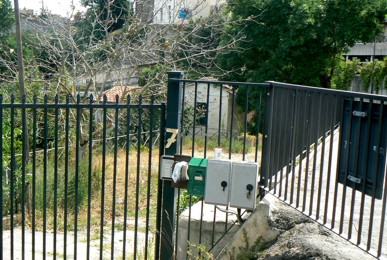
[Filomena’s shutters on approach above and below NOT half-open as they were when Knox arrived]
Additional to this post and this post on the overwhelming strength of the evidence against Sollecito and Knox.
Amanda Knox was of course lying from the start about her initial visit to the cottage to have a shower and collect a change of clothing, in the account which she gave the police when they turned up, and which she then embellished into a version of Little Red Riding Hood in her e-mail.
Here’s how we can know why. One of her most glaringly untrue claims, one not hard to fathom out and indeed I have no doubt that she had done so herself and regretted it within minutes of recounting her story to the police.
The shutters to Filomena’s window were open upon the arrival of the postal police. Massei (page 27) -
Said window had two half-closed shutters, and the right-hand shutter (the right with respect to the person looking at it) was slightly more open”› (page 62, hearing of February 6, 2009, Battistelli’s statements).
Filomena’s window is in fact the most prominent feature of the cottage for anyone walking down the lane to it. Yet, incredibly, if we are to make sense of the rest of her account, we are required to believe that Knox did not notice the shutters .
Whether they were half open or less than half open does not matter. They were open, indicating, as a matter of common sense, that the occupant of the room might be somewhere around.
You would think that anyone (anyone but Knox apparently) apprised of this elementary scrap of information about their own home and flatmates, and then in addition finding that the front door was open and no-one was answering, would have checked the other rooms, and in particular Filomena’s, out of curiosity if not concern, wouldn’t you? Of course you would.
Discovery of the broken window would then, if not before, have been inevitable, but of course in those circumstances no one would have believed that she had then had a shower and blow dried her hair.
Of course it did occur to the police that her story was a load of nonsense, just as it did to Knox and Sollecito.
See at bottom here for the famous picture of Knox and Sollecito together outside the cottage, Knox with her left hand up to her eyes and Sollecito by her side standing with his back to the window, jaws clenched and staring blankly straight ahead.
They knew, and they must have been praying hard that the police were just as stupid as them. When they were not arrested on the spot they must have thought their prayers were answered.
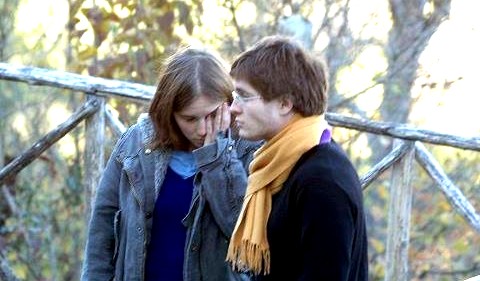
[Shower? Knox with Sollecito several hours later at which point her body odour was reported as immense]

